C#
Caffe Framework#
PyTorch is not an end-to-end machine learning development tool; the development of actual applications requires conversion of the PyTorch code into another framework such as Caffe2 to deploy applications to servers, workstations, and mobile devices.
More at:
See also C, Deep Learning Framework
Caikit Toolkit#
Caikit is an AI toolkit that enables users to manage models through a set of developer friendly APIs. It provides a consistent format for creating and using AI models against a wide variety of data domains and tasks.
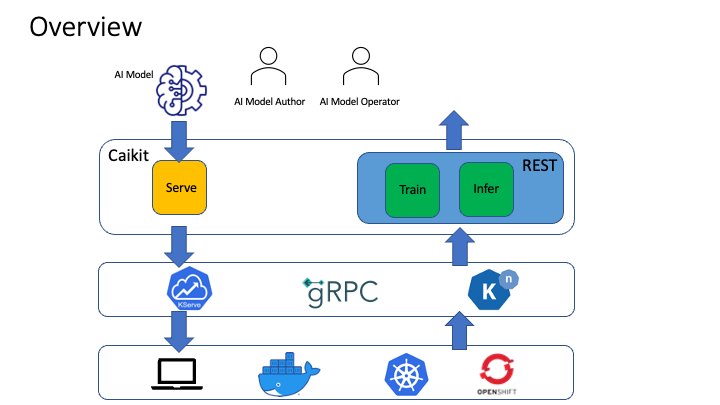
More at:
See also C, ...
Capcha#
More at:
- TRoCr
See also C, ...
Carbon emission#
- Electricity ~consumption: Servers and drives need electricity to operate. It is as easy as checking the electricitiy bill.
- Power Usage Effectiveness (PUE): Energy is also needed to run the overall data center facility -- e.g. lighting, cooling, and support functions. This overhead consumption is a multiplier termed PUE!
- Grid Efficiency Factor (GEF): The GEF also called Carbon Intensity, measures the amount of carbon emissions per unit of electricity generated.

More at:
- ...
See also C, ...
Carnegie Mellon University (CMU)#
More at:
See also C, ...
Case-Based Reasoning (CBR)#
In artificial intelligence and philosophy, case-based reasoning (CBR), broadly construed, is the process of solving new problems based on the solutions of similar past problems.
In everyday life, an auto mechanic who fixes an engine by recalling another car that exhibited similar symptoms is using case-based reasoning. A lawyer who advocates a particular outcome in a trial based on legal precedents or a judge who creates case law is using case-based reasoning. So, too, an engineer copying working elements of nature (practicing biomimicry), is treating nature as a database of solutions to problems. Case-based reasoning is a prominent type of analogy solution making.
It has been argued that case-based reasoning is not only a powerful method for computer reasoning, but also a pervasive behavior in everyday human problem solving; or, more radically, that all reasoning is based on past cases personally experienced.
See also C, ...
Cassandra Database#
~ a column database that can be used for vector search.
More at:
See also C, ...
Casual Language Modeling#
Based on the context (previous words) find out the most likely following work. One that word is found, the new word is used to estimate the next one.
See also C, Autoregressive Model, Decoder, GPT Model, [Natural Language Generation]
Catastrophic Forgetting (CF)#
Catastrophic forgetting, also known as catastrophic interference, is a phenomenon primarily observed in artificial neural networks, particularly in the context of machine learning and deep learning. It refers to the tendency of a neural network to completely forget previously learned information upon learning new information. This issue is especially prominent in scenarios involving sequential or continual learning, where a model is trained on a series of tasks one after the other.
Here are some key points about catastrophic forgetting:
- Description: When a neural network is trained on a new task or dataset, it tends to adjust its weights significantly to accommodate the new information. If the new task is significantly different from the previous tasks, the network might lose the ability to perform well on the old tasks, as the weights that were important for those tasks are overwritten.
- Example: Consider a neural network trained to recognize cats. If the same network is subsequently trained to recognize dogs without revisiting the cat images, it might lose the ability to recognize cats, even if it was proficient at this task before the dog training.
- Causes: Catastrophic forgetting occurs because traditional neural networks lack a mechanism to retain old knowledge while acquiring new information. The weight updates during the training of new tasks can disrupt the knowledge acquired from previous tasks.
- Impact in AI: This phenomenon is a significant challenge in the field of artificial intelligence, especially for systems that require continual learning or learning from a stream of data (like autonomous vehicles or personalized AI assistants)
- Solutions and Research: Various techniques are being researched and developed to mitigate catastrophic forgetting. These include:
- Elastic Weight Consolidation (EWC) - A method that slows down learning on certain weights based on their importance to previous tasks.
- Experience Replay - Storing a subset of old data and mixing it with new data during training.
- Progressive Neural Networks - Networks that retain a pool of models or layers for each task and combine them in ways that can leverage old knowledge without overwriting it.
- Continual Learning Approaches: Architectures and training strategies specifically designed to allow models to learn continuously over time without forgetting.
Catastrophic forgetting remains an area of active research, as overcoming this challenge is crucial for developing more versatile and robust AI systems capable of learning and adapting over time without losing their previous capabilities.
More at:
- paper
- main - https://www.sciencedirect.com/science/article/abs/pii/S0079742108605368?via%3Dihub
- CF in LLM during SFT - https://arxiv.org/abs/2308.08747
See also C, ...
Catastrophic Inference#
See [Catastrophic Forgetting]
CatBoost Python Module#
CatBoost is a machine learning method based on gradient boosting over decision trees.
Main advantages:
- Superior quality when compared with other GBDT libraries on many datasets.
- Best in class prediction speed.
- Support for both numerical and categorical features.
- Fast GPU and multi-GPU support for training out of the box.
- Visualization tools included.
- Fast and reproducible distributed training with Apache Spark and CLI.
More at:
- https://towardsdatascience.com/9-awesome-python-packages-for-machine-learning-that-should-deserve-more-credit-dbad17263145
- https://github.com/catboost/catboost
- https://github.com/catboost/tutorials/#readme - tutorials
See also C, ...
Categorical Feature#
A feature that takes discrete non-numerical value, such as a shirt size (XS, S, M, L, XL) or gender (M, F). Because computer works with numbers, to be processed categorical features are normally turned into discrete variables.
See also C, Discrete Variable, Variable Type
Cell Block#
A cell in jupyter!
Central Limit Theorem#
In probability theory, the central limit theorem (CLT) establishes that, in many situations, when independent random variables are summed up, their properly normalized sum tends toward a normal distribution even if the original variables themselves are not normally distributed.
See also C, Gaussian Distribution
Central Processing Unit (CPU)#
See also C, GPU, [Lambda], [Hyperparameter Optimization]
Central Processing Unit (CPU) Memory#
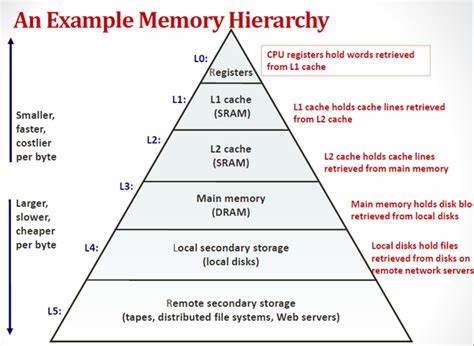
See also C, ...
Chain-Of-Table#
More at:
- paper - https://arxiv.org/abs/2401.04398
- blog - https://blog.research.google/2024/03/chain-of-table-evolving-tables-in.html
See also C, [Chain-Of-Throught]
Chain-Of-Thought (COT) Prompting#
~ A Prompt Engineering technique
A solution to get the explainability of a model OR RATHER ITS OUTPUT! Generating a chain of thought -- a series of intermediate reasoning steps -- significantly improves the ability of large language models to perform complex reasoning. In particular, we show how such reasoning abilities emerge naturally in sufficiently large language models via a simple method called chain-of-thought prompting, where a few chain-of-thought demonstrations are provided as exemplars in prompting. Experiments on three large language models show that chain-of-thought prompting improves performance on a range of arithmetic, commonsense, and symbolic reasoning tasks. The empirical gains can be striking. For instance, prompting a 540B-parameter language model with just eight chain of thought exemplars achieves state of the art accuracy on the [GSM8K benchmark] of math word problems, surpassing even fine-tuned GPT-3 with a verifier.
Variations:
- Zero-shot COT
- Few-shot COT
- Automatic COT

More at:
- variations - https://www.promptingguide.ai/techniques/cot
- paper - https://arxiv.org/abs/2201.11903
See also C, Chain-Of-Table, [Explanability]
Chained Model#
Each model does one thing. e.g. verifier.
Character AI Company#
Talk to a famous person or character! You can also create your own!
More at:
- site - https://beta.character.ai/
- articles
See also C, ...
Characteristic Stability Index (CSI)#
When our model’s Population Stability Index(PSI) was in the “warning” zone between 0.1 a 0.2. We now need to understand which features may have caused the drift. Enter CSI.
The Characteristic Stability Index (CSI) is used to evaluate the stability or drift of each feature so that we can find the problematic one. As PSI is concerned with the effects of the population drift on the model’s predictions, the CSI is concerned with understanding how the feature distributions have changed.
Using it is really simple: we just apply the same formula we used for PSI, but instead of binning the data by using the predicted variable, we use each feature to create the bins.
More at:
- articles
- code - https://github.com/vinyluis/Articles/tree/main/Model%20Stability
See also C, Data Drift, Model Stability, [Population Stability Index]
Chatbot#
~ A computer application that uses machine learning to have a conversation with a human.
Can be a
See also C, ...
Chatbot Arena#
Chatbot Arena is new a tool that allows you to compare the output of over 25 LLMs directly from your browser. It supports a mix of closed and open-source LLMs, including well-known ones like OpenAI's [GPT-4Turbo] and Mistral-8x7b.
It also lets users vote on which one provides better responses, and, this is where the magic is. Behind-the-scenes, you're creating the most robust LLM benchmark, one based on user experience. It’s like a real-world test lab where your votes shape the leaderboards. Think of it as crowdsourcing – the more you interact and vote, the clearer the picture we get of which models really deliver.
These votes feed into an Elo rating system, which is the same method used in chess to rank player skill. Each model starts with a base score, and gains or loses points based on the user votes - a win against a higher-ranked model scores more points, while losing to a lower-ranked model costs more.
This offers three big innovations:
- It scales to many models without costly paired evaluations. The Elo system handles relative ranking even if models don't directly compete.
- New models can be quickly measured with a handful of matches. No need to wait for statistical significance across multiple comparisons.
- The leaderboard gives a clear view of state-of-the-art. As votes accumulate, model ratings converge.
The rankings already reveal some trends. Closed models like GPT-4 lead, but Mistral's [mixture-of-experts architecture] is closing the gap. And previous leaders like LLaMA now trail unexpectedly.
Highlights
- OpenAI remains the king of LLMs
- Claude is second best performing closed model
- Closed models still outperform open models (but the gap is closing)
- Mistral-8x7b is the best open-source model right now
- [Yi-34B] is flying under the radar
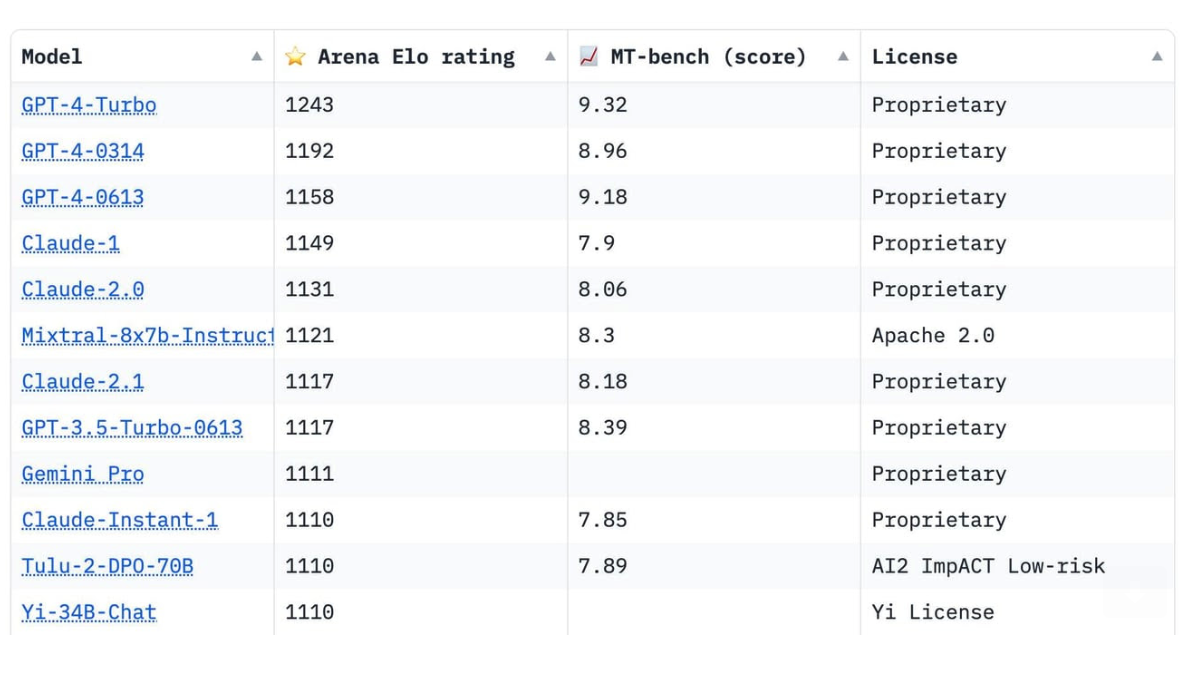
More at:
See also C, Multi-Turn Question Set Benchmark
ChatGPT Model#
A GPT model that has a state, that is you can have a discussion/dialog with the device. This model is fine-tuned with "supervised" interactions as was done with the InstructGPT model, a precursor to ChatGPT. In recent weeks, the internet has been going crazy with the new ChatGPT model. In general, ChatGPT is part of a series of releases around GPT 3.5 that are highlighting some of the capabilities of the upcoming GPT-4 model. One of the key differences of ChatGPT with previous models is its ability to follow instructions. This is powered another model called InstructGPT which OpenAI quietly unveiled at the beginning of the year.
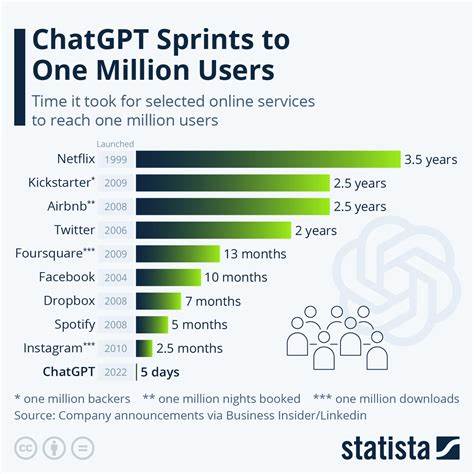

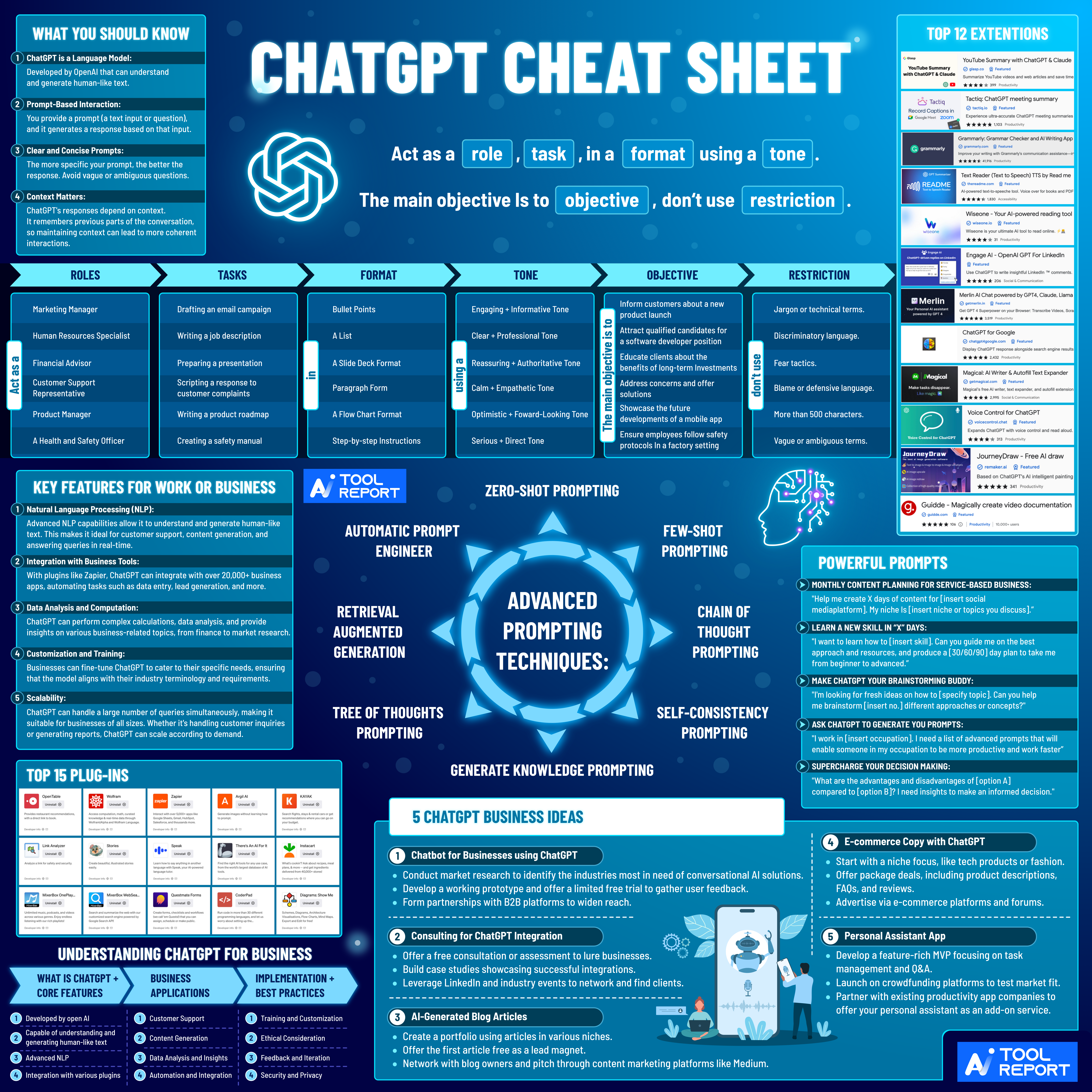
More at:
- training explained - https://medium.com/mlearning-ai/a-new-ai-buzz-chatgpt-training-explained-cafd253ce442
- adoption rate - https://www.linkedin.com/pulse/chatgpts-100m-users-2-months-more-impressive-than-you-gilad-nass/
- gpt vs chatgpt vs instructgpt - https://medium.com/@colin.fraser/chatgpt-automatic-expensive-bs-at-scale-a113692b13d5
- prompt engineering - https://www.promptingguide.ai/
- webgpt chrome extension - https://twitter.com/DataChaz/status/1610556519531089921
- https://www.cnn.com/2022/12/05/tech/chatgpt-trnd/index.html
- https://medium.com/@colin.fraser/chatgpt-automatic-expensive-bs-at-scale-a113692b13d5
- https://www.technologyreview.com/2023/01/26/1067299/chatgpt-workout-plans/
- articles
- 2024/10/03 - canvas introduction - https://openai.com/index/introducing-canvas/
- 1 year anniversary - https://aimagazine.com/machine-learning/chatgpts-first-birthday-a-year-in-review
- how was built - https://www.technologyreview.com/2023/03/03/1069311/inside-story-oral-history-how-chatgpt-built-openai/
- college essay is dead - https://www.theatlantic.com/technology/archive/2022/12/chatgpt-ai-writing-college-student-essays/672371/
See also C, Chatbot, Digital Watermark, Feedback, Plagiarism Checker, Reward Model, Reinforcement Learning, Sparrow Model
ChatGPT Plugin#
Give external tools to ChatGPT
# CANVA
Create 2 social media posts that educate my target audience, females ages 30-40 located in Canada, on how wearing sustainable fashion in the winter is better for the environment. Make sure to include an image template, text to go on the image post and text for the caption.
# 2 linkReader + 1 Canva plugin calls
Links
* https://paloalto.midtown.ai/tracks/aws-deepracer-league
* https://aws.amazon.com/deepracer/
Create 2 social media posts that educate my target audience, male high-schoolers ages 15-18 located in Palo Alto, CA, on the best way to compete in the student AWS DeepRacer League is by joining the Midtown AI club. Make sure to include an image template, text to go on the image post and text for the caption.
See also C, ...
Checkpointing#
Child Development Milestone#
Skills such as taking a first step, smiling for the first time, and waving “bye bye” are called developmental milestones. Children reach milestones in how they play, learn, speak, act, and move.
More at:
- https://www.cdc.gov/ncbddd/actearly/milestones/index.html
- https://www.autonomousagents.stanford.edu/modeling-human-learning-and-develop
See also C, ...
Chinchilla Model#
An optimized model of Goopher. Achieved the same performance with fewer parameters!
More at:
- paper - https://arxiv.org/abs/2203.15556
See also C, ...
Chinchilla Scaling Law#
See also C, ...
Chroma Database#
An in-memory [vector datatabase] ...
import chromadb
client = chromadb.Client()
collection = client.create_collection("test")
collection.add(
embeddings=[
[1.1, 2.3, 3.2],
[4.5, 6.9, 4.4],
[1.1, 2.3, 3.2],
[4.5, 6.9, 4.4],
[1.1, 2.3, 3.2],
[4.5, 6.9, 4.4],
[1.1, 2.3, 3.2],
[4.5, 6.9, 4.4],
],
metadatas=[
{"uri": "img1.png", "style": "style1"},
{"uri": "img2.png", "style": "style2"},
{"uri": "img3.png", "style": "style1"},
{"uri": "img4.png", "style": "style1"},
{"uri": "img5.png", "style": "style1"},
{"uri": "img6.png", "style": "style1"},
{"uri": "img7.png", "style": "style1"},
{"uri": "img8.png", "style": "style1"},
],
documents=["doc1", "doc2", "doc3", "doc4", "doc5", "doc6", "doc7", "doc8"],
ids=["id1", "id2", "id3", "id4", "id5", "id6", "id7", "id8"],
)
query_result = collection.query(
query_embeddings=[[1.1, 2.3, 3.2], [5.1, 4.3, 2.2]],
n_results=2,
)
print(query_result)
{'ids': [['id1', 'id5'], ['id2', 'id4']], 'embeddings': None, 'documents': [['doc1', 'doc5'], ['doc2', 'doc4']], 'metadatas': [[{'uri': 'img1.png', 'style': 'style1'}, {'uri': 'img5.png', 'style': 'style1'}], [{'uri': 'img2.png', 'style': 'style2'}, {'uri': 'img4.png', 'style': 'style1'}]], 'distances': [[0.0, 0.0], [11.960000038146973, 11.960000038146973]]}
More at:
- home - https://www.trychroma.com/
- docs - https://docs.trychroma.com/getting-started
- colab
- notebooks
- Articles
See also C, ...
CIDEr Score#
See also C, [MSFT COCO Caption Dataset]
CICERO Model#
A Model built by Meta.
Diplomacy is what AI researchers call a “seven player, zero sum and deterministic game of imperfect information”. A seven player game is much harder to solve than a two player game such as chess or Go. You must consider the many possible strategies of not one but six other players. This makes it much harder to write an AI to play the game. Diplomacy is also a game of imperfect information, because players make moves simultaneously. Unlike games such as chess or Go, where you know everything about your opponent’s moves, players in Diplomacy make moves not knowing what their opponents are about to do. They must therefore predict their opponents’ next actions. This also adds to the challenge of writing an AI to play it. Finally, Diplomacy is a zero sum game in which if you win, I lose. And the outcome is deterministic and not dependent on chance. Nonetheless, before victory or defeat, it still pays for players to form alliances and team up on each other. Indeed, one of the real challenges in playing the game is managing the informal negotiations with other players before making simultaneous moves. The main reason Cicero’s performance is a scientific breakthrough is that it can both play the game well, and also perform these informal negotiations. This combination of natural language processing and strategic reasoning is a first for any game-playing AI.
More at:
- site - https://ai.facebook.com/research/cicero/
- https://about.fb.com/news/2022/11/cicero-ai-that-can-collaborate-and-negotiate-with-you/
- https://ai.facebook.com/blog/cicero-ai-negotiates-persuades-and-cooperates-with-people/
- science article (private) - https://www.science.org/doi/10.1126/science.ade9097?fbclid=IwAR1is0uOvw8uSQaJjTNKeevCKanq3TnVsLiS2wY0RwHX3zreCuwqPHKTcVI
- science article (public) - https://www.science.org/content/article/ai-learns-art-diplomacy-game?cookieSet=1
- request for proposal - https://ai.facebook.com/research/request-for-proposal/towards-human-AI-cooperation/
- gizmodo - https://www.gizmodo.com.au/2022/11/an-ai-named-cicero-can-beat-humans-in-diplomacy-a-complex-alliance-building-game-thats-a-big-deal/
See also C, ...
CIFAR Dataset#
Datasets created by Alex Krizhevsky for the AlexNet Model
Datasets * CIFAR-10 = 10 different categories * CIFAR-100i = 100 different categories
The CIFAR-10 dataset (Canadian Institute For Advanced Research) is a collection of images that are commonly used to train machine learning and computer vision algorithms. It is one of the most widely used datasets for machine learning research. The CIFAR-10 dataset contains 60,000 32x32 color images in 10 different classes/categories. The 10 different classes represent airplanes, cars, birds, cats, deer, dogs, frogs, horses, ships, and trucks. There are 6,000 images of each class. Computer algorithms for recognizing objects in photos often learn by example. CIFAR-10 is a set of images that can be used to teach a computer how to recognize objects. Since the images in CIFAR-10 are low-resolution (32x32), this dataset can allow researchers to quickly try different algorithms to see what works. CIFAR-10 is a labeled subset of the 80 million tiny images dataset. When the dataset was created, students were paid to label all of the images.

More at
- https://www.geeksforgeeks.org/cifar-10-image-classification-in-tensorflow/
- https://maet3608.github.io/nuts-ml/tutorial/cifar10_example.html
- CIFAR 10 - https://knowyourdata-tfds.withgoogle.com/dataset=cifar10
- CIFAR 100 - https://knowyourdata-tfds.withgoogle.com/dataset=cifar100
Class Imbalance#
Classical AI#
See Symbolic AI
Classification Task#
A type of supervised learning algorithm. The goal in classification is to take input values and organize them into two or more categories. The categories are normally mutually exclusive (ex is this shape a circle, a rectangle or a triangle? Beware of 3-d shape projections, i.e. perspectives!). An example classification use case is fraud detection. In fraud detection, the goal is to take information about the transaction and use it to determine if the transaction is either fraudulent or not fraudulent. When XGBoost is given a dataset of past transactions and whether or not they were fraudulent, it can learn a function that maps input transaction data to the probability that transaction was fraudulent.
Classification Types:
- Binary Classifier
- [Multi-class Classifier]
- [Multi-label Classifier]
Classification algorithms: * Supervised * Learning Vector Quantization (LVQ) * Unsupervised * K-Means Clustering * [LVQ Algorithm] * Semi-supervised * K-Nearest Neighbors (KNN) * Others * Decision tree * [Logistic regression] * Support Vector Machine (SVM) - [boundary zone] is an hyperplane * Random Forest * [Boosted Trees] with XGBoost or LightGBM * Naive Bayes Classifier * Gaussian Naive Bayes Classifier * Multinomial Naive Bayes Classifier
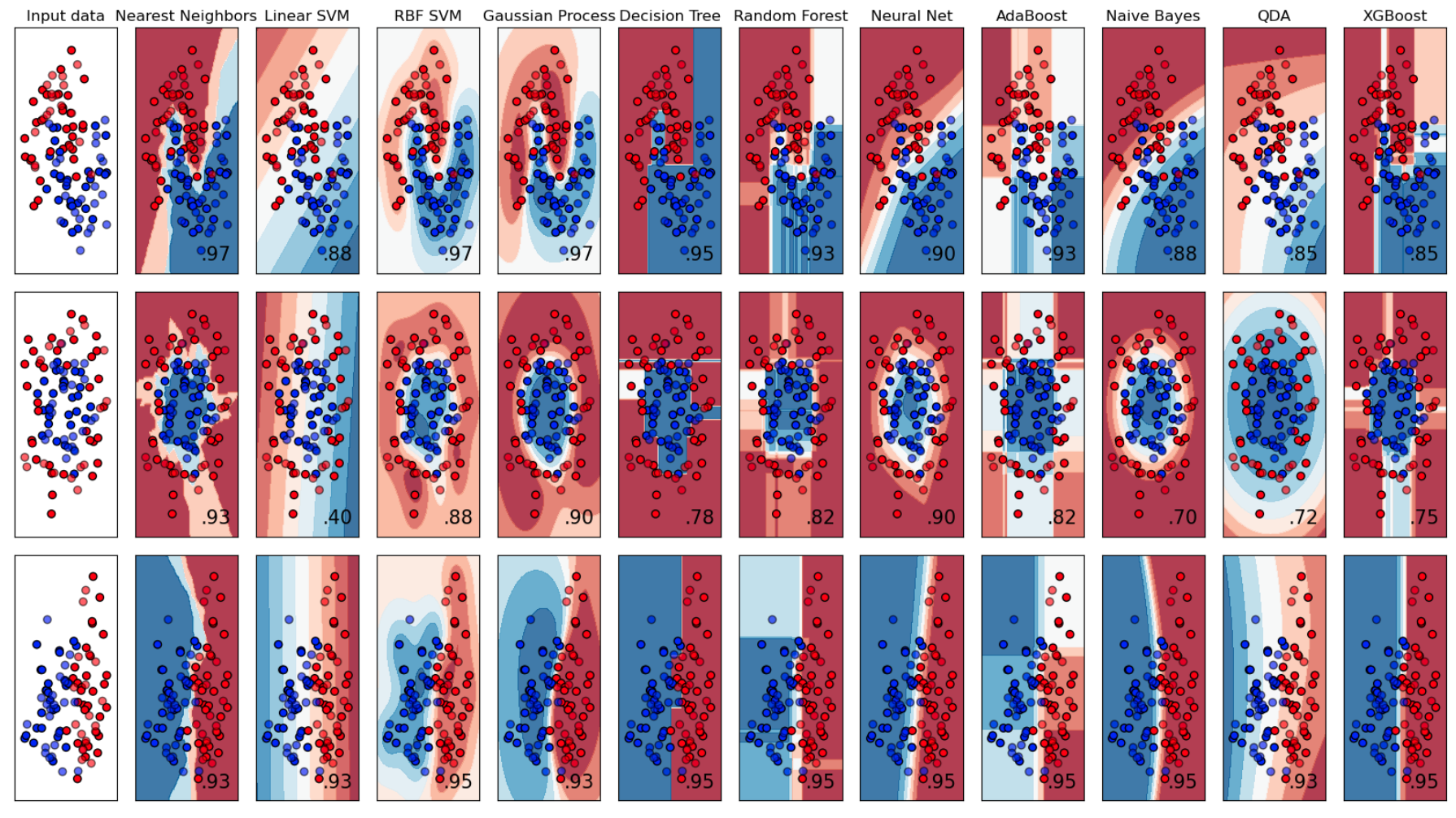
See also C, Binary Classification, Multi-class Classification, Supervised Learning
Classification Report#
~ a report as informative as the confusion matrix !
includes:

See also C, ...
Claude Model#
An LLM built by Anthropic that uses a constitutional AI
More at:
- cost estimate - https://orenleung.com/anthropic-claude-next-cost
- UI - https://console.anthropic.com/chat/a38ac87b-b229-455a-b742-58b4639cf995
-
papers
- claude 3 model card -
-
articles
- claude 3
- video summarization - https://github.com/hundredblocks/transcription_demo
- claude 2
- annoucement - https://www.vox.com/future-perfect/23794855/anthropic-ai-openai-claude-2
- constitutional AI
- https://www.computerworld.com/article/3707410/amazon-set-to-invest-4b-in-constitutional-ai-advocate-anthropic.html
See also C, ...
Clever Hans Effect#
The Clever Hans effect refers to an incident in the early 1900s involving a horse named Hans that appeared to have remarkable mathematical abilities. Here are some key points about the Clever Hans effect:
- Hans was a horse owned by Wilhelm von Osten, a German mathematics teacher. Von Osten claimed Hans could solve math problems, tell time, read, spell, and understand German.
- Hans would tap his hoof to answer questions. For example, when asked to add 3 + 2, he would tap his hoof 5 times.
- Hans became a sensation in Germany, attracting crowds who marveled at his intelligence. However, after investigation, it was determined his abilities were an unintentional trick.
- The Clever Hans effect refers to an instance where it appears an animal (or person) has capabilities beyond expectations, but in reality is inadvertently receiving subtle cues from questioners that guide their behavior.
- With Hans, it was determined people were unintentionally cuing the horse by slightly leaning forward, making facial expressions, or tensing muscles when Hans reached the correct number of taps. This provided Hans the signal to stop tapping.
- The Clever Hans effect illustrates how easy it is for people to inadvertently guide behaviors through subtle, unconscious cues. It demonstrates the need for proper experimental controls when evaluating extraordinary claims of animal or human intelligence.
So in summary, the Clever Hans effect refers to situations where it appears an animal or person has remarkable abilities, but in reality is just responding to subtle behavioral cues from others. It's a fascinating case that revealed the need for scientific rigor in evaluating claims of high intelligence.
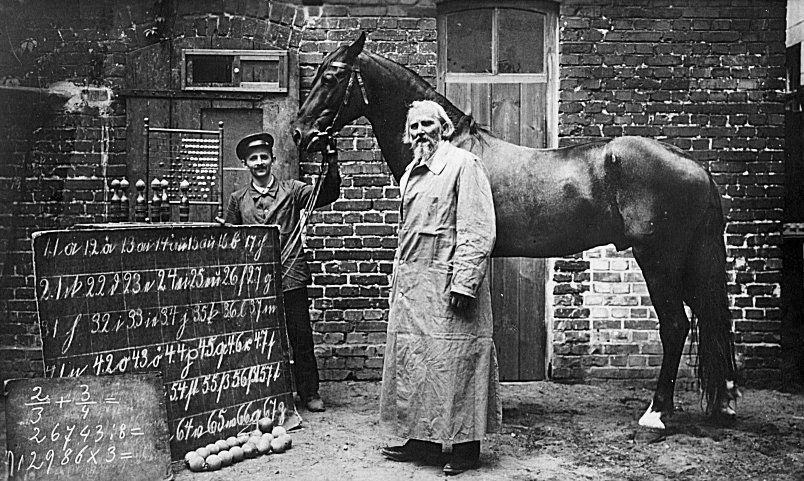
More at:
See also C, ...
CLIP Image Encoder#
Encode an image into the embedding space.
See also C, CLIP Model, Embedding Space, Encoder
CLIP Text Encoder#
Encode a text prompt into the embedding space.
See also C, CLIP Model, Embedding Space, Encoder
Clipping#
~ Used to keep values within a range.
It works as follow:
- If the value is too high, it is replaced by the max clipping value.
- If the value is too low, it is replace by the min clipping value.
- If the value is within the clipping range, the value is not changed.
Clipping is required in algorithms that use momentum/impulse.
Used in algorithm such as:

See also C, ...
Clustering#
Ex: Clustering is also used by internet radio services; given a collection of songs, a clustering algorithm might be able to group the songs according to their genres. Using different similarity measures, the same clustering algorithm might group the songs by their keys, or by the instruments they contain. ==> Classification
Algorithms:
- Learning Vector Quantization (LVQ) - (un)Supervised?
- K-Means Clustering - Semi-supervised
See also C, Initialization, Unsupervised Learning
CM3leon Model#
~ text to image by Meta
More at:
- paper - https://ai.meta.com/research/publications/scaling-autoregressive-multi-modal-models-pretraining-and-instruction-tuning/
- announcement - https://ai.meta.com/blog/generative-ai-text-images-cm3leon/
See also C, ...
CNTK#
CNTK is ...
See also C, ...
Coalition for Content Provenance and Authenticity (C2PA)#
An open technical standard providing publishers, creators, and consumers the ability to trace the origin of different types of media.
More at:
- site - https://c2pa.org/
See also C, ...
Code Synthesis#
Generation of code by machines
See also C, ...
Codex Model#
A model built by OpenAI
See also C, ...
Cognitron#
See also C, Neocognitron
Cognosys AI Company#
Build a UI for their task-driven autonomous agent
More at:
- home - https://www.cognosys.ai/
- blog - https://www.cognosys.ai/blog
See also C, ...
Cohen's Kappa Metric#
is excellent for measuring agreement between the validator and human judgments, especially for subjective tasks. It accounts for the possibility of agreement by chance, providing a more robust measure than simple agreement percentages.
More at:
See also C, ...
Cohere AI Company#
Cohere (stylized as co:here) is a Canadian startup that provides Natural Language Processing (NLP) models that help companies improve human-machine interactions. Cohere was founded in 2019 by Aidan Gomez, Ivan Zhang, and Nick Frosst.
More at:
Collaborative Filtering#
Used for recommendation of song/movies/etc where people mark what they like. If a person A has the same tastes as another person B, then what person B likes will be recommended to person A.
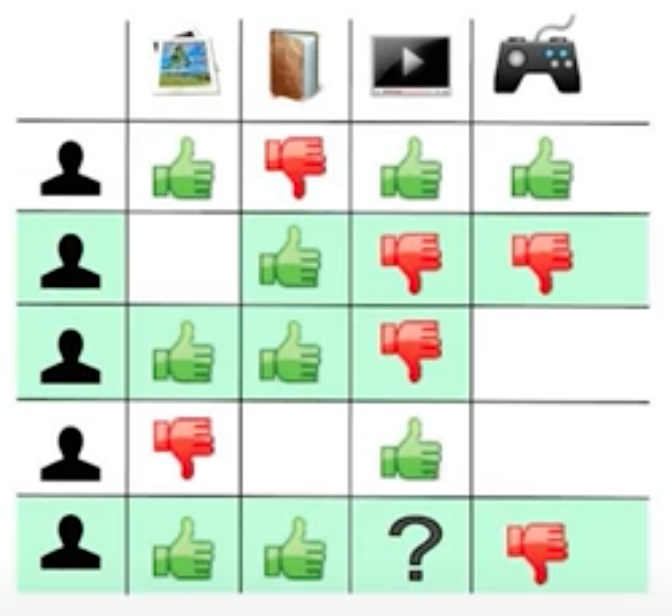
The problem with this approach is that if a new song/movie is made available, it cannot be recommended! ( = Cold start problem )
See alsoC, ...
Colossal Clean Crawled Corpus (C4)#
To accurately measure the effect of scaling up the amount of pre-training, one needs a dataset that is not only high quality and diverse, but also massive. Existing pre-training datasets don’t meet all three of these criteria — for example, text from Wikipedia is high quality, but uniform in style and relatively small for our purposes, while the Common Crawl web scrapes are enormous and highly diverse, but fairly low quality.
To satisfy these requirements, we developed the Colossal Clean Crawled Corpus (C4), a cleaned version of Common Crawl that is two orders of magnitude larger than Wikipedia. Our cleaning process involved deduplication, discarding incomplete sentences, and removing offensive or noisy content. This filtering led to better results on downstream tasks, while the additional size allowed the model size to increase without overfitting during pre-training.
More at:
See also C, Corpus, Dataset, T5 Model
Common Crawl Corpus#
Common Crawl is a 501(c)(3) non–profit founded in 2007. The Common Crawl corpus contains petabytes of data, regularly collected since 2008.
Common Crawl data is stored on Amazon Web Services’ Public Data Sets and on multiple academic cloud platforms across the world.
- Web Archive (WARC) - the ultimate data source
- Metadata (WAT) - contains just the metadata from each page, the request info, things from head of HTML, and links from the webpage
- web Text (WET) - contains just the webpage title, and plain text extracted from the HTML of each response.
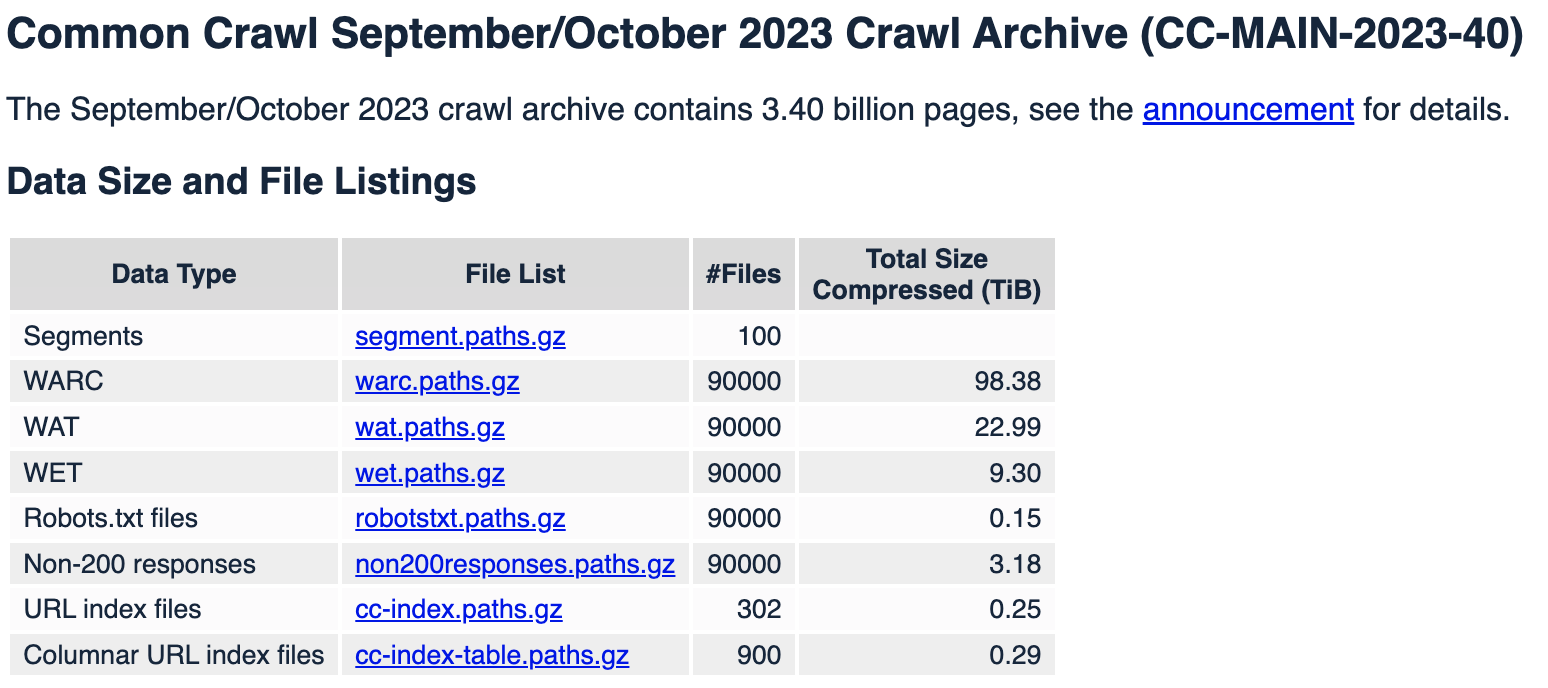
More at:
- site - https://commoncrawl.org/
- blog - https://commoncrawl.org/blog
- ARC format - https://archive.org/web/researcher/ArcFileFormat.php
- articles
See also C, ...
Common Sense#
- Theory of Mind
- Social common sense
- Physical common sense
- Visual common sense
- Norms and morals
More at:
- https://bdtechtalks.com/2022/08/08/machines-like-us-review/
- TED talk - https://www.ted.com/talks/yejin_choi_why_ai_is_incredibly_smart_and_shockingly_stupid
See also C, Cyc Expert System
Company#
Example of companies are:
- Abnormal Security - Email cyberattack detection (Forbes)
- Adept AI - AI model developer. Focus on AGI through automation of tasks on desktops (Forbes)
- Adobe - Offer a midjourey alternative called Firefly
- AlphaSense - Focus on market intelligence search (Forbes)
- Alibaba - A copycat of Amazon but in China
- Amazon - Focus on public cloud and partnership with 3rd parties
- Anduril Industries - Focus on defense software with AI (Forbes)
- Anyscale - Compute engine Buildup on the Ray Framework
- Apple - Large company in the world, strangely not so influential in the AI industry. At least not yet!
- Arize - Focus on data issue detection (Forbes)
- Baidu - Chinese search engine
- Bayesian Health - Focus on patient risk detection (Forbes)
- BHuman - Focus on creating deepfake of yourself!
- Canvas - Focus on construction robots
- Character AI - Chatbot with a persona
- Clari - Focus on sales software
- Coactive AI - Data labelling software
- Cognosys AI - Task driven autonomous agent, similar to AutoGPT
- Cohere AI - Focus on NLP applications
- [Copy AI] -
- valentine AI - https://www.valentinesday.ai/
- Databricks - Data storage and analytics
- Descript - Video and podcast editing
- Eightfold AI - Recruiting software
- ElevenLabs AI - Focus on Text-to-speech rendition
- FarmWise Labs - Weeding tractors for farming
- Fermat: Collaboration canvas with AI
- Futuri Media - Content selection for media, such as tv and radio. Includes RadioGPT!
- GitHub - Code repositories with advanced features including AI pair programming with Codex
- Glean - Internal workplace search
- Gong - Sales software
- Got It AI - ELMAR LLM for the enterprise with truth checker!
- Gretel AI -
- Harvey - Digital assistant for lawyers
- Hugging Face - Open-source AI library, a model hub, with datasets, and space/UI with Gradio
- Inflection AI - A chatbot that listens and talks
- Insitro - Drug discovery
- Ironclad - Legal contract management
- Jasper - Copywriting software
- Kasisto - Build an [intelligent digital assistant] for finance projects
- Kumo AI - Pytorch Geometric
- Microsoft - One of the largest company in the world, leading changes with AI
- Midjourney AI - AI image generator
- MosaicML - AI model training tools
- Moveworks - Automated IT support
- Neeva - Personalized search engine
- Neptune AI -
- Neuralink - A company lead by Elon Musk that is focusing on human Brain Machine Interfaces
- Pachama - Forestry satellite data analysis
- PathAI - Drug discovery and diagnosis
- PolyAI - Voice chatbots
- Quora - A static Q&A internet site that is not offering an interface to chatbots though its interface, poe.
- Replicate - Run and fine-tune open-source models. Deploy custom models at scale. All with one line of code.
- Replika - Build AI companion who cares!
- RevComm - Voice analysis software (Forbes)
- Runway - Focus on generative AI for images and now videos
- Sakana AI - Foundation model based on nature-inspired intelligence !?!?
- Seamless AI - To get sales leads
- Scale AI - Data labeling provider
- Shield AI - Autonomous defense software
- Sima AI - AI at the edge (MLSoc)
- Slingshot Aerospace - Space simulation software
- Snorkel AI - Data labeling software
- Supertranslate AI - Focus on generating proper subtitles to videos
- Synthesia - Focus on AI avatars
- Trigo - Cashierless retail checkout
- Turnitin - AI writing detector
- Vannevar Labs - Defense intelligence software
- Vectra AI - Cyberattack detection
- VIZ.AI - Disease detection
- Waabi - Autonomous trucking technology
- Weights & Biases - Developer tools for AI + MLOps and LLMOps
- Writer - Copywriting software
Deployment:
Digital Humans and Meta-Humans:
Driverless cars / Robotaxi:
Drug Discovery:
- BigHat Biosciences - Better biologics faster through ML-guided design
- Isomorphic Labs - Spin off from DeepMind and building on AlphaFold
- Unlearn.AI - Clinical trial forecasting
Education:
- Chegg - AI assistant called CheegMate
- Duolingo - Learn a language with role play with Duolingo Max
- Khan Academy - AI assistant called Khanmigo
- Kuros AI - College prep
- strategy planning + personal qualities + academic fitness/alignment + communication and organization + ExtraCurricular activities fitness/alignment + Applications
- Magic School AI - help teachers create a lesson plan. Assistant is called Raina
- Pearson - No bot yet! Still in denial?
Evaluation:
- Deepchecks - SaaS platform for RAG metrics and penetration testing
Foundation Model:
- Anthropic - Focus on LLM, building an alternative to GPT models (Forbes)
- DeepMind - Focus on AI applications in science
- Google - Known for its search engine and ad-placement business model. Challenged by Microsoft
- Meta - Formerly known as Facebook with a strong focus on the multiverse and more recently on AI
- OpenAI - Focus on democratizing AI. Known for releasing ChatGPT
- Stability AI - Focus on diffusion model or image generation, adopted the open-source philosophy
- xAI - Backed by Elon Musk and builder of Grok LLM and PromptIDE
Hardware:
- AMD - Another supplier of GPUs
- Cortical Labs - Use biological [neurons] to use as AI
- Intel - Build CPUs and now includes tensor processing in them
- Koniku - Use biological [neurons] to compete with regular computers
- Nvidia - The leading supplier of GPU
Human-Machine Interface:
- Open Interpreter - voice interface to your home computer
- Humane - The AI pin likely to replace the cell phone? Works as a microphone?
- Rabbit - With the R1 device
Industry research:
- Evident Insights - currently focused on the banking industry
Inference Accelerator:
- Cerebras - 20x faster than NVIDIA GPU or 450 TK/S
- Groq - Superfast LLM inference because baked by custom hardware? or 250 TK/S
- Together AI -
AI Cloud Services:
- Cloud AI Security
- Cloud GPUs
- CoreWave - Kubernetes native cloud that’s purpose-built for large scale, GPU-accelerated workloads.
- Curoe - Reliable high-performance GPUs, CPUs, networking, and storage for AI exploration, model training and scalable-inference.
- Lambda Labs - access to GPU for deeplearning
Music:
- Audialab - drum sound only
- Aiva AI -
- Boomy -
- Harmonai -
- LoudMe AI -
- MelodyStudio -
- Mubert -
- Suno AI - generate music for your lyrics!
- TuneFlow
- Udio - An alternative to Suno AI
Powerpoint:
- Beautiful AI -
- Gammas -
- Tome -
Robotics:
- Boston Dynamics - Focus on robotics
- Covariant AI - Created the [Robotics Foundation Model]
- Engineered Arts - Focus on social robots, such as Ameca
- Figure AI - Focus on creating humanoids such as Figure-01
- Hanson Robotics - Build humanoid for consumer, entertainment, service, healthcare, and research applications.
- Softbank Robotics - Focus on social robots
- [Trossen Robotics] - Build research robots
Search:
- AndiSearch -
- Exa AI - search through a UI or API
- Perplexity AI
- You
Security:
- Lakera - filter the output
Synthetic data:
- Datagen - Synthetic data for faces/images
- Mostly AI - Generative AI for tabular data
- Synthetic Users - Use AI users and study the deviation!
Text-To-Speech:
- [PlayHT] - Convert words to audio/voice
Vector Databases:
- [Chroma] - in memory database (good for development!)
- Milvus - project supported by the LFAI&Data
- Pinecone - building the [Pinecone Database]
Video:
- Wonder Dynamics - VFX in a single click!
World model:
- [World Lab] - RL on Environments + NeRF
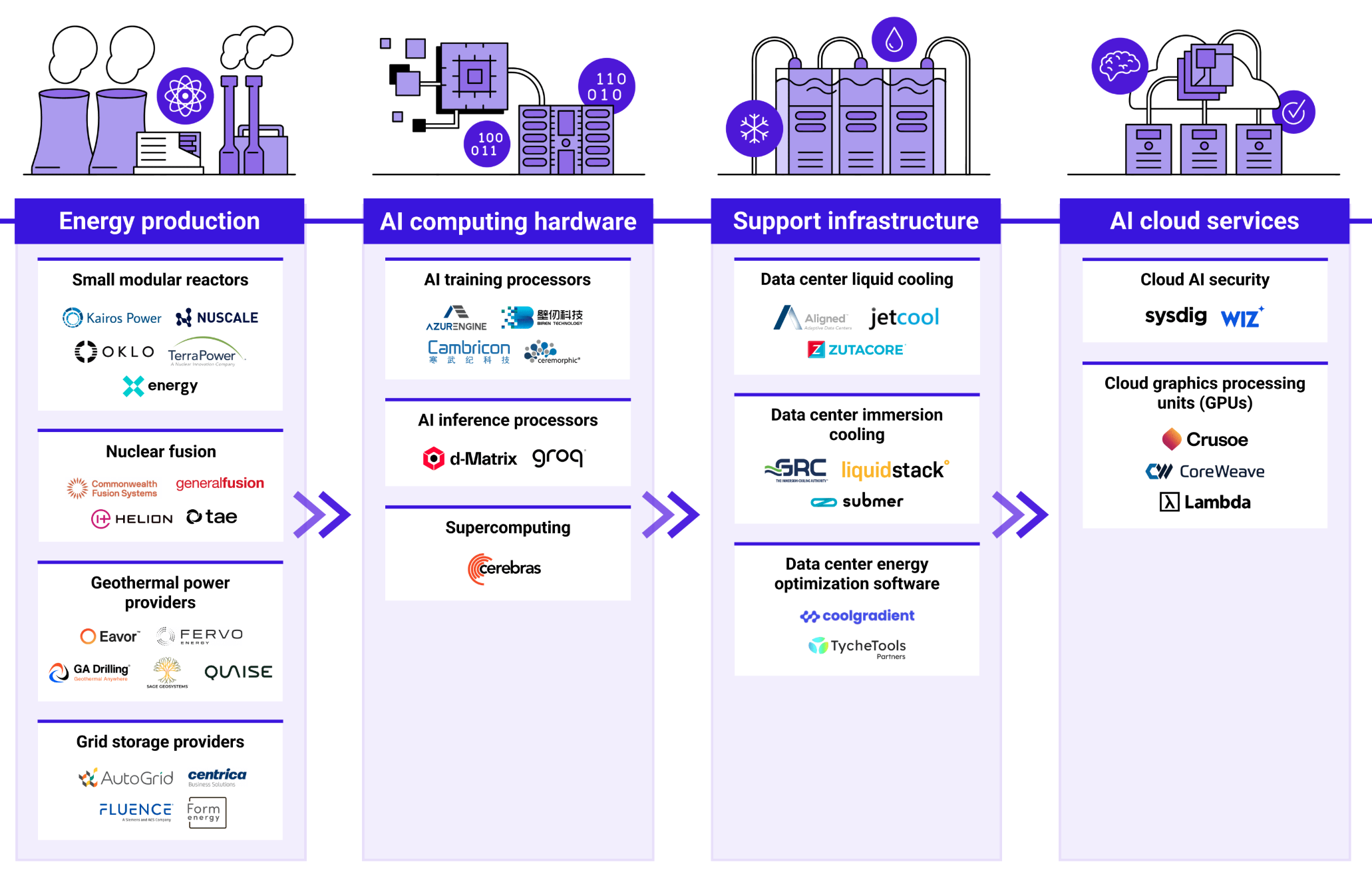
More at:
- CBInsights
- ML, AI, Data (MAD)
- interactive - https://mad.firstmark.com/
- 2023 blog post - https://mattturck.com/mad2023/
- 2021 blog post - https://mattturck.com/mad2021/
- Forbes AI top 50:
- 2023
- https://www.forbes.com/lists/ai50/?sh=1f9472b1290f
- https://www.forbes.com/sites/kenrickcai/2023/04/11/ai-50-2023-methodology-judges/?sh=5b1ec13b4f73
- 2022 - https://www.forbes.com/sites/helenpopkin/2022/05/06/ai-50-2022-north-americas-top-ai-companies-shaping-the-future/?sh=63dcbbdc34b5
- 2021 - https://www.forbes.com/sites/alanohnsman/2021/04/26/ai-50-americas-most-promising-artificial-intelligence-companies/?sh=12d718d177cf
- CNBC disruptor 50:
See also C, ...
COMPAS Model#
One of several different "risk assessment" tools used in the US criminal legal system.
More at:
See also C, ...
Complexity#
Complexity (of a model) is
- Attention-based model: for input sequence of length N, each layer's output is NxN (all to all comparison) and therefore each layer is o(N^2) for sequence of length N
See also C, Hyperparameter, Attention-Based Model
Complexity Ceiling#
The concept of a "complexity ceiling" in expert systems refers to the practical limits on the complexity and scale of knowledge that can be effectively represented and utilized within these systems. This limitation arises from several factors:
- Knowledge acquisition bottleneck: As the domain becomes more complex, it becomes increasingly difficult and time-consuming to gather, formalize, and encode all the relevant expert knowledge.
- Rule interaction: In large rule-based systems, the interactions between rules can become extremely complex and difficult to manage, leading to unexpected behaviors or conflicts.
- Maintenance challenges: As the knowledge base grows, maintaining and updating the system becomes progressively more difficult and error-prone.
- Performance issues: Very large knowledge bases can lead to decreased system performance, as the inference engine must search through a vast number of rules and facts.
- Brittleness: Expert systems often struggle with handling situations outside their specific domain of expertise, becoming less reliable as the problem space expands.
- Lack of common sense reasoning: Traditional expert systems typically lack the ability to reason about general knowledge and common sense, which limits their adaptability to new or unusual situations.
These limitations often mean that expert systems are most effective when applied to well-defined, narrow domains rather than broad, open-ended problem spaces. More recent approaches in AI, such as machine learning and deep learning, have been developed in part to address some of these limitations.
See also C, [Cyc Export System]
Compliance#
Regulatory landscape refers to the complete framework of laws, rules, and regulations that govern an industry or business activity. This includes:
- All applicable laws and regulations
- Government agencies and regulatory bodies
- Current and upcoming regulatory requirements
- Policy directions and regulatory trends
Compliance focuses specifically on what organizations need to do to meet those regulatory requirements, including:
- Internal policies and procedures
- Systems and controls needed for adherence
- Monitoring and reporting mechanisms
- Staff training and awareness programs
- Documentation requirements
Think of it this way: The regulatory landscape is "what the rules are," while the compliance is "how organizations follow those rules."
See also C, ...
Compliance Analysis#
This is ...
See also C, ...
Compound AI System#
We define a Compound AI System as a system that tackles AI tasks using multiple interacting components, including multiple calls to models, retrievers, or external tools. In contrast, an AI Model is simply a statistical model, e.g., a Transformer that predicts the next token in text.
More at:
See also C, [Retrieval Augmented Generation System]
Compute Efficient Frontier#
One of the 3 Neural Scaling Law
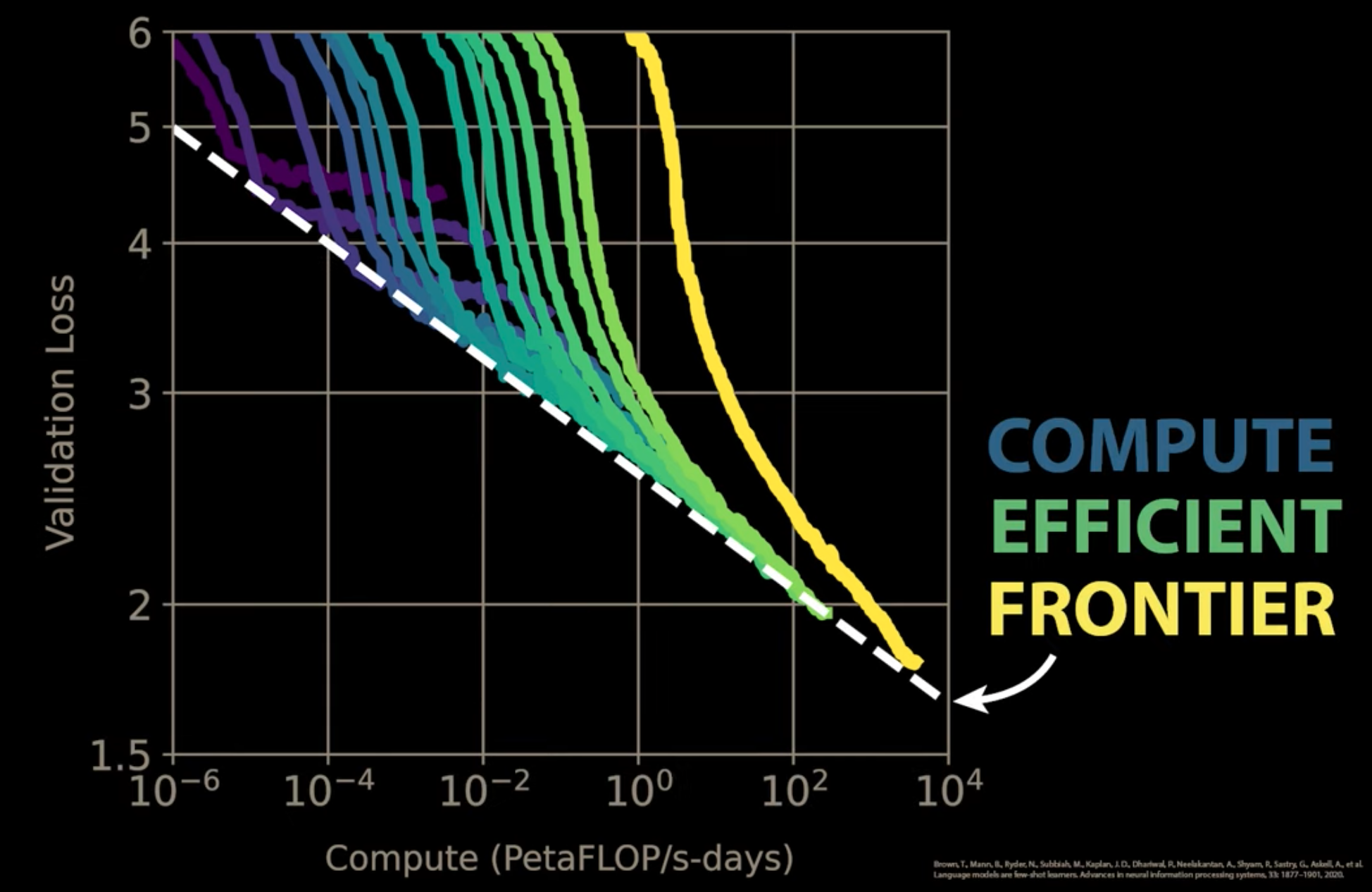
See also C, ...
Computer Vision (CV)#
See also C, Convolutional Neural Network, [OpenCV Library], ResNET Model
Computer Vision and Pattern Recognition (CVPR) Conference#
An AI conference related to computer vision and pattern recognition
More at:
- twitter - https://twitter.com/cvpr/
- https://cvpr2023.thecvf.com/
- https://cvpr2022.thecvf.com/
- https://cvpr2021.thecvf.com/
See also C, ...
Concept Video#
Here is an example of concept video of a Knoledge Navigator that later became the Siri Virtual Assistant
{% include vimeoPlayer.html id=25551192 %}
More at:
See also C, ...
Concurrency#
Concurrency in the context of indexing refers to the ability of a database management system to handle multiple transactions simultaneouslyy without causing data inconsistency or corruption. In other words, it ensures that data remains consistent and accurate even when multiple users are accessing it at the same time.
See also C, ...
Conda CLI#
Command line interface to create a python environment
# Create environment
conda search "^python$" | tail
conda create -n pytorch_env python=3.10 # Create environment pytorch with a specific version of python
conda activate pytorch_env
conda install pytorch torchvision torchaudio cpuonly -c pytorch
conda install ipykernel # <-- VScode interactive
conda install seaborn -c anaconda
conda install scikit-learn # Use default channel "defaults" for installation
conda install detecto -c conda-forge # A channel for all packages to be installed
conda install conda-force::numpy # A channel per package
conda env export pytorch > pytorch_env.yml
# With Export
More at:
- docs - https://docs.conda.io/projects/conda/en/latest/index.html
- cheatsheet - https://docs.conda.io/projects/conda/en/latest/user-guide/cheatsheet.html
See also C, ...
Conditioning#
See also C, Diffusion Model, [Latent Diffusion Model]
Conditional GAN (CGAN)#
In this GAN the generator and discriminator both are provided with additional information that could be a class label or any modal data. As the name suggests the additional information helps the discriminator in finding the conditional probability instead of the joint probability.
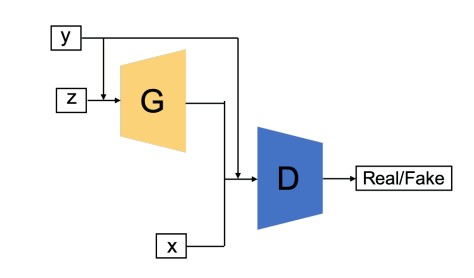
See also C, [Generative Adversarial Network]
Conditional Random Fields#
See also C, Discriminative Classifier
Confidence Interval#
A confidence interval is the range of values needed to match a confidence level for estimating the features of a complete population.
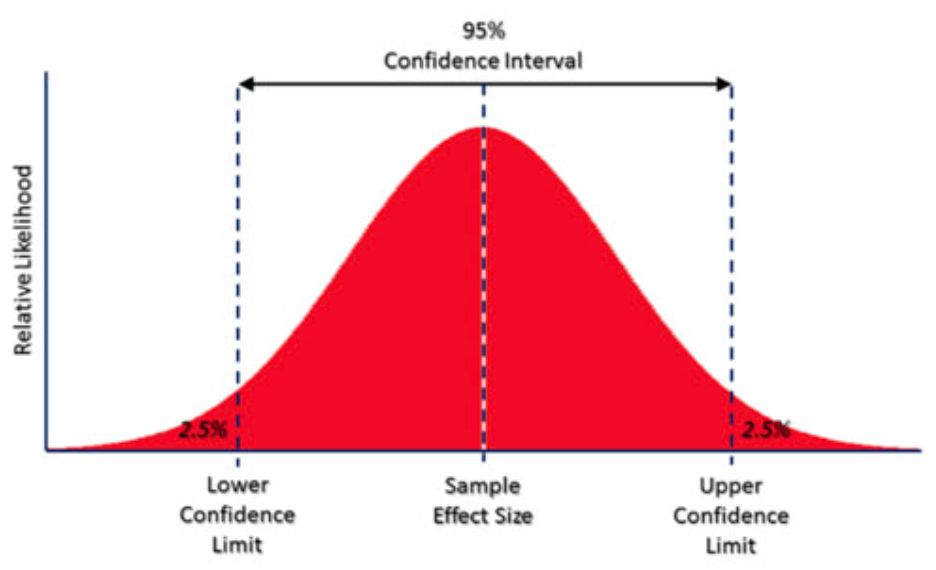
See also C, Gaussian Distribution
Confusion Matrix#
~ a report as informative as the classification report !
A Confusion matrix is an N x N matrix used for evaluating the performance of a classification model, where N is the number of target classes. The matrix compares the actual target values with those predicted by the machine learning model. In the case where N=2 (true or false), it shows false and true positive as well as false and true negative.
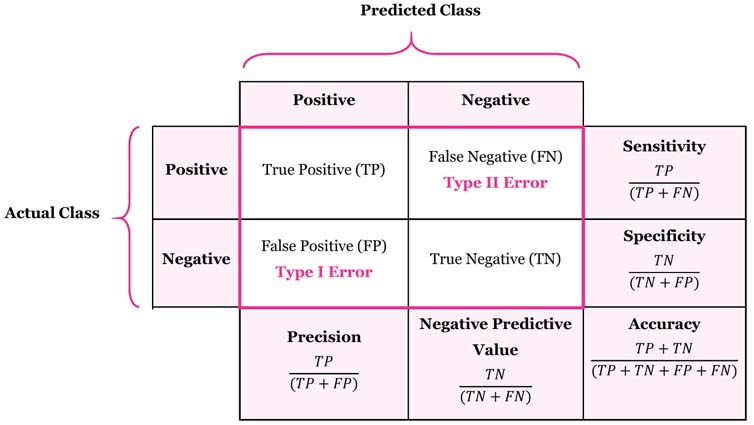
Beware:
- precision = recall !
- specificity = precision if classes in binary classifier are inverted!
- precision = true positive / total positive

More at:
See also C, Accuracy, Classification, Model Drift, Prediction Error
Constitutional AI#
~ based on Sparrow's rule?
How does a language model decide which questions it will engage with and which it deems inappropriate? Why will it encourage some actions and discourage others? What “values” might a language model have?
These are all questions people grapple with. Our recently published research on “Constitutional AI” provides one answer by giving language models explicit values determined by a constitution, rather than values determined implicitly via large-scale human feedback. This isn’t a perfect approach, but it does make the values of the AI system easier to understand and easier to adjust as needed.
More at:
- paper - "https://arxiv.org/abs/2212.08073"
- announcements - https://www.anthropic.com/news/claudes-constitution
- site - https://www.constitutional.ai/
- articles
See also C, ...
Constraint Satisfaction Problem#
More at:
See also C, Variable Model
Consumer Electronic Show (CES)#
See also C, ...
Context Window#
~ short term memory of a LLM
See also C, ...
Continual Reinforcement Learning (CRL)#
Consider an agent learning to play Go: Once the agent has discovered how to master the game, the task is complete, and the agent’s learning can stop. This view of learning is often embedded in the standard formulation of Reinforcement Learning (RL), in which an agent interacts with a Markovian environment with the goal of efficiently identifying an optimal behavior, at which point learning can cease. But what if this is not the best way to model the RL problem? That is, instead of viewing learning as finding a solution, we can instead think of it as endless adaptation
An Reinforcement Learning (RL) problem is an instance of CRL if the best agents never stop learning. 
More at:
- paper - https://arxiv.org/abs/2307.11046
- articles
See also C, ...
Continuous Action Space#
In Reinforcement Learning, a non-finite set of Actions. You define a minimum and a maximum, i.e. a range, for your parameters and the agent can select a value for that range automatically.
See also C, ...
Continuous Convolution#
See also C, Discrete Convolution
Continuous Variable#
A variable that can take any value, possibly within a range.
See also C, Variable Type
Contrastive Language Image Pre-training (CLIP) Model#
CLIP is a dual-encoder contrastive model that was developed by OpenAI and released open-source in 01/05/2021
CLIP is a vision-language model that aligns image and text representations into a shared embedding space. is trained on large-scale image and text pair datasets to obtain a unified representation of different representations for the same concept. For that, an image encoder and a text encoder separately map images and text into a high-dimensional space, and a distance-based loss is utilized to enforce representations of identical concepts in neighborhood regions. CLIP is another neural network that is able to determine how well a caption (or prompt) matches an image. In other words, CLIP is a neural network that efficiently learns visual concepts from [natural language supervision].
Model:
- large scale learning - bigger transformer models for image and text embeddings
- trained on 400 million (image, text) pairs using ConVIRT model trained fro scratch
- pre-training method: predicting only which text as a whole is paired with which image and not the exact words of that text (contrastive, i.e. binary-classification task/approach for matching text to image)
- Use vision transformer to reduce training time and required compute resources compared with ResNet model.
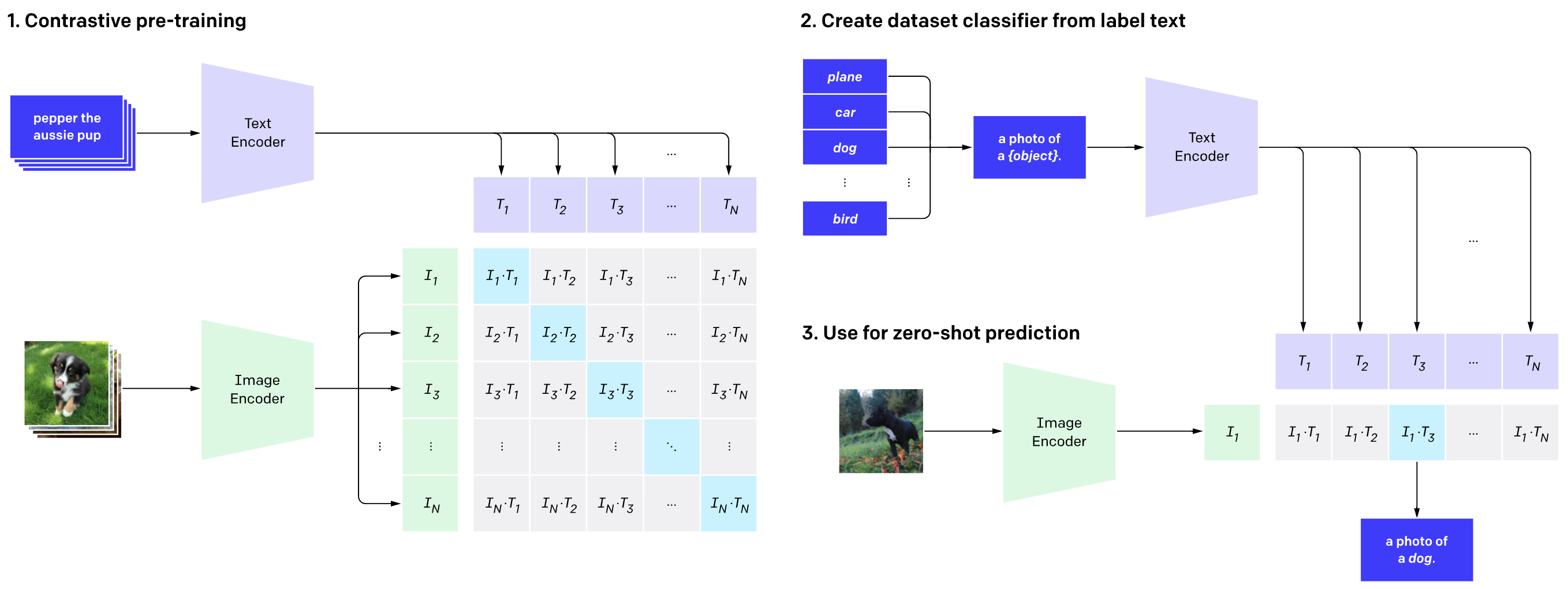
More at:
- site - https://openai.com/research/clip
- code - https://github.com/openai/CLIP
- paper - https://arxiv.org/abs/2103.00020
- announcement - https://openai.com/blog/clip/
- Hugging Face docs - https://huggingface.co/docs/transformers/model_doc/clip#transformers.CLIPTextModel
- more
- Hierarchical Text-Conditional Image Generation with CLIP Latents (paper) - https://arxiv.org/abs/2204.06125
- articles
See also C, CLIP Image Encoder, CLIP Text Encoder, Embedding Space, Vision Transformer, [VQGAN]
Contrastive Learning#
See also C, [Contrastive Loss]
Contrastive Loss Function#
See also C, Contrastive Learning, Loss Function
Control System#
A control system is a system that manages and regulates the behavior or operation of another system or process. It typically consists of sensors, actuators, and a controller. The sensors gather information about the system's current state, which is then compared to a desired state or setpoint. The controller processes this information and generates control signals that are sent to the actuators to adjust the system's inputs or parameters. The objective of a control system is to maintain the system's behavior within desired limits or achieve specific goals.
Control systems are a set of devices, components, and algorithms designed to regulate and manipulate the behavior of dynamic systems. These systems can be mechanical, electrical, chemical, or biological in nature. Control systems aim to maintain desired outputs or states by continuously monitoring and adjusting inputs or control signals. They play a crucial role in automation, robotics, manufacturing, and various other fields.
See also C, ...
ControlNet External Network#
~ diffusion model + prompt + DEPTH MAP/CONDITIONAL INPUT ==> image ! (without retraining the diffusion model)
warning
diffusion model is frozen
the external model takes the DEPTH MAP/CONDITIONAL INPUT
We present ControlNet, a neural network architecture to add spatial conditioning controls to large, pretrained text-to-image diffusion models. ControlNet locks the production-ready large diffusion models, and reuses their deep and robust encoding layers pretrained with billions of images as a strong backbone to learn a diverse set of conditional controls. The neural architecture is connected with "zero convolutions" (zero-initialized convolution layers) that progressively grow the parameters from zero and ensure that no harmful noise could affect the finetuning. We test various conditioning controls, eg, edges, depth, segmentation, human pose, etc, with Stable Diffusion, using single or multiple conditions, with or without prompts. We show that the training of ControlNets is robust with small (<50k) and large (>1m) datasets. Extensive results show that ControlNet may facilitate wider applications to control image diffusion models.
More at:
- paper - https://arxiv.org/abs/2302.05543
- code - https://github.com/lllyasviel/ControlNet-v1-1-nightly
- articles
See also C, Hypernetwork Architecture
Convolution#
In math, Convolution = Merging the shape of 2 functions together. Ex: Function that fires fireworks * smoke for 1 firework overtime = smoke in the air at a specific time ( = cumulative add all contribution of all firework)
....
More at:
See also C, Convolutional Neural Network, Image Filter
Convolution Autoencoder#
A CNN to latent space, and from latent space to a deconvolution neural network ?
See also C, [Convolution Neural Network], Deconvolution Neural Network
Convolutional Layer#
~ A stack of convoluted images (one per kernel filter)
The goal of a convolutional layer is filtering!
The output of a convolutional layer is a stack of convoluted images (stack of images convoluted with each image filter)
In a CNN, each layer tries to recognize different patterns (i.e. extract features).
Once executed, each resulting values is subject to an activation function (a.k.a processed by the activation layer i.e. ReLu Layer ) and then compressed using a pooling layer
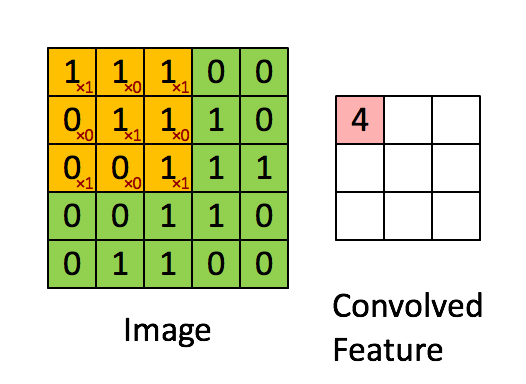
The output of a convolutional layer is a stack of [convolved features]

See also C, Convolutional Neural Network, [Fully Connected Layer], Image Filter, Max Pooling Layer
Convolutional Neural Network (CNN)#
Particularly useful for image analysis/processing such as object recognition, image classification, semantic segmentation (object in image), artistic style transfer (filter on an image with the style of another image often a painting), meow generator (find cats in image?) . The idea is that the pixel are not completely independent from the one surrounding them. CNN takes the surrounding pixel into consideration as well instead of just an independent pixel. Use filter. Max Pooling layers (dimension reduction of outputs to downstream layers to convert a tensor into a vector). A succession of convolution-subsampling layers. Example: Does a pixel belongs to an object or not? .
A CNN consists of :
- Convolutional Layers
- Activation Layers such as RELU Layers
- Pooling Layers such as Max Pooling Layers
- and [Fully Connected Layers]
In a CNN, the image filters are learned through backpropagation
import torchvision
from torch.utils.data import DataLoader
import torch
from torch import nn
from torch import optim
from torch.utils.tensorboard import SummaryWriter
import numpy as np
import os
transform_train = torchvision.transforms.Compose([
torchvision.transforms.RandomHorizontalFlip(),
torchvision.transforms.ToTensor(),
torchvision.transforms.Normalize((0.4914, 0.4822, 0.4465), (0.2023, 0.1994, 0.2010))
])
transform_test = torchvision.transforms.Compose([
torchvision.transforms.ToTensor(),
torchvision.transforms.Normalize((0.4914, 0.4822, 0.4465), (0.2023, 0.1994, 0.2010)),
])
train_dataset = torchvision.datasets.CIFAR10("/mnt/cifar10/", train=True, transform=transform_train, download=True)
train_dataloader = DataLoader(train_dataset, batch_size=32, shuffle=False)
test_dataset = torchvision.datasets.CIFAR10("/mnt/cifar10/", train=False, transform=transform_test, download=True)
test_dataloader = torch.utils.data.DataLoader(test_dataset, batch_size=32, shuffle=False)
class CIFAR10Model(nn.Module):
def __init__(self):
super().__init__()
self.cnn_block_1 = nn.Sequential(*[
nn.Conv2d(3, 32, 3, padding=1),
nn.ReLU(),
nn.Conv2d(32, 64, 3, padding=1),
nn.ReLU(),
nn.MaxPool2d(kernel_size=2),
nn.Dropout(0.25)
])
self.cnn_block_2 = nn.Sequential(*[
nn.Conv2d(64, 64, 3, padding=1),
nn.ReLU(),
nn.Conv2d(64, 64, 3, padding=1),
nn.ReLU(),
nn.MaxPool2d(kernel_size=2),
nn.Dropout(0.25)
])
self.flatten = lambda inp: torch.flatten(inp, 1)
self.head = nn.Sequential(*[
nn.Linear(64 * 8 * 8, 512),
nn.ReLU(),
nn.Dropout(0.5),
nn.Linear(512, 10)
])
def forward(self, X):
X = self.cnn_block_1(X)
X = self.cnn_block_2(X)
X = self.flatten(X)
X = self.head(X)
return X
clf = CIFAR10Model()
start_epoch = 1
clf.cuda()
criterion = nn.CrossEntropyLoss()
optimizer = optim.RMSprop(clf.parameters(), lr=0.0001, weight_decay=1e-6)
def train():
clf.train()
NUM_EPOCHS = 10
for epoch in range(start_epoch, NUM_EPOCHS + 1):
losses = []
for i, (X_batch, y_cls) in enumerate(train_dataloader):
optimizer.zero_grad()
y = y_cls.cuda()
X_batch = X_batch.cuda()
y_pred = clf(X_batch)
loss = criterion(y_pred, y)
loss.backward()
optimizer.step()
train_loss = loss.item()
if i % 200 == 0:
print(
f'Finished epoch {epoch}/{NUM_EPOCHS}, batch {i}. loss: {train_loss:.3f}.'
)
losses.append(train_loss)
print(
f'Finished epoch {epoch}. '
f'avg loss: {np.mean(losses)}; median loss: {np.median(losses)}'
)
train()

The hidden layers are designed to process the input in a way that optimizes for signal and image processing /recognition. ==> recognize features instead of pixel!
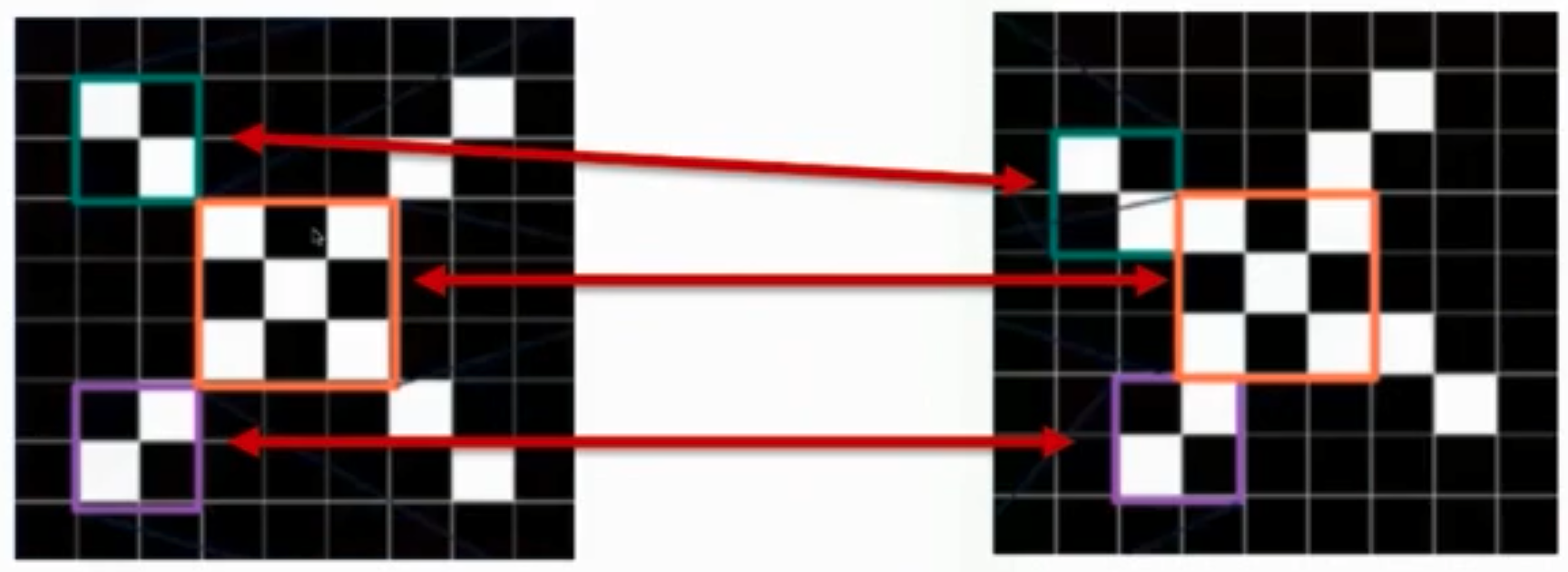
When using kernel, we are implicitly saying that pixel outside of the kernel do not have an impact on ... This is where attention-based models may be better than CNN, where attention to other pixel in the image needs to be taken into consideration
More at:
- what CNN see
- https://setosa.io/ev/image-kernels/
- https://heartbeat.fritz.ai/the-5-computer-vision-techniques-that-will-change-how-you-see-the-world-1ee19334354b
- https://medium.com/easyread/an-introduction-to-convolution-neural-network-cnn-for-a-beginner-88548e4b2a84
- https://e2eml.school/how_convolutional_neural_networks_work.html
- https://yosinski.com/deepvis
See also C, Attention-Based Model, Convolution, Deconvolution Neural Network, Instance Segmentation, Latent Space, Neural Network, Object Detection, Picasso Visualizer, Pooling Layer, [Region-Based CNN], Semantic Segmentation, Subsampling
Convolutional Neural Network (CNN) Feature Extractor#
When using a CNN, ... ResNet Model
{% pdf "../pdf/c/convolutional_neural_network_feature_extractor_paper.pdf" %}
More at:
See also C, ...
Convolved Feature#
The result of a convolution of an input image with a image filter. The output of a convolutional layer is a stack of convolved features.
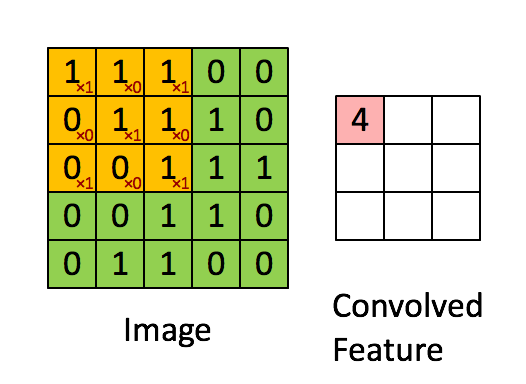
More at:
See also C, ...
Coral Hardware#
A Tensor Processing Unit (TPU) compatible with any computer including the Raspberry Pi Computer
More at:
- https://www.amazon.com/Google-G950-01456-01-Coral-USB-Accelerator/dp/B07S214S5Y
- https://teachablemachine.withgoogle.com/
- marshmallow sorter - https://coral.ai/projects/teachable-sorter#project-intro
See also C, ...
Coreference#
Understand the entities a speak refers to when he uses nouns, pronouns. ex I, You, my sister, your sister, etc Function of the speaker perspective.
More at:
CoreML Format#
Format for ML models to load on devices made by Apple
See also C, ...
CoreML Framework#
Switch UI programming language
More at:
See also C, CoreML Format, CoreML Tool
CoreML Tool#
Tools to convert models to CoreML Format, etc and integrate a model in CoreML Framework
More at:
See also C, ...
Corpus#
GPT-3 is pre-trained on a corpus of text from five datasets: Common Crawl, WebText2, Books1, Books2, and Wikipedia..
- Colossal Clean Crawled Corpus (C4) : Used by T5 model
- Common Crawl : The Common Crawl corpus (collection of texts) comprises petabytes of data including raw web page data, metadata, and text data collected over eight years of web crawling. OpenAI researchers use a curated, filtered version of this dataset.
- Web2text : WebText2 is an expanded version of the WebText dataset, which is an internal OpenAI corpus created by scraping web pages of particularly high quality. To vet for quality, the authors scraped all outbound links from Reddit that received at least three karma (an indicator for whether other users found the link interesting, educational, or just funny). WebText2 contains 40 gigabytes of text from these 45 million links, over 8 million documents.
- Book1 and Book2 : Books1 and Books2 are two corpora (plural of corpus) that contain the text of tens of thousands of books on various subjects.
- Wikipedia : The Wikipedia corpus is a collection including all English-language articles from the crowdsourced online encyclopedia Wikipedia at the time of finalizing the GPT-3’s dataset in 2019. This dataset has roughly 5.8 million English articles.
See also C, Dataset, GPT Model, Natural Language Processing
Corrective Retrieval Augmented Generation (CRAG) System#
~ an improved version of RAG that aims to make language models more accurate
While traditional RAG simply uses retrieved documents to help generate text, CRAG takes it a step further by actively checking and refining these documents to ensure they are relevant and accurate. This helps reduce errors or hallucinations where the model might produce incorrect or misleading information.
In CRAG, the retrieval evaluator is a fine-tuned T5-large model. The evaluator assigns a confidence score to each document, categorizing them into three levels of confidence:
- Correct: If at least one document scores above the upper threshold, it is considered correct. The system then applies a knowledge refinement process, using a decompose-then-recompose algorithm to extract the most important and relevant knowledge strips while filtering out any irrelevant or noisy data within the documents. This ensures that only the most accurate and relevant information is retained for the generation process.
- Incorrect: If all documents fall below a lower threshold, they are marked as incorrect. In this case, CRAG discards all the retrieved documents and instead performs a web search to gather new, potentially more accurate external knowledge. This step extends the retrieval process beyond static or limited knowledge base by leveraging the vast and dynamic information available on the web, increasing the likelihood of retrieving relevant and accurate data.
- Ambiguous: When the retrieved documents contain mixed results, it will be considered ambiguous. In this case, CRAG combines both strategies: it refines information from the initially retrieved documents and incorporates additional knowledge obtained from web searches.
After one of these actions is taken, the refined knowledge is used to generate the final response.
CRAG makes several key improvements over traditional RAG. One of its biggest advantages is its ability to fix errors in the information it retrieves. The retrieval evaluator in CRAG helps spot when information is wrong or irrelevant, so it can be corrected before it affects the final output. This means CRAG provides more accurate and reliable information, cutting down on errors and misinformation.
CRAG also excels in making sure the information is both relevant and accurate. While traditional RAG might only check relevance scores, CRAG goes further by refining the documents to ensure they are not just relevant but also precise. It filters out irrelevant details and focuses on the most important points, so the generated text is based on accurate information.
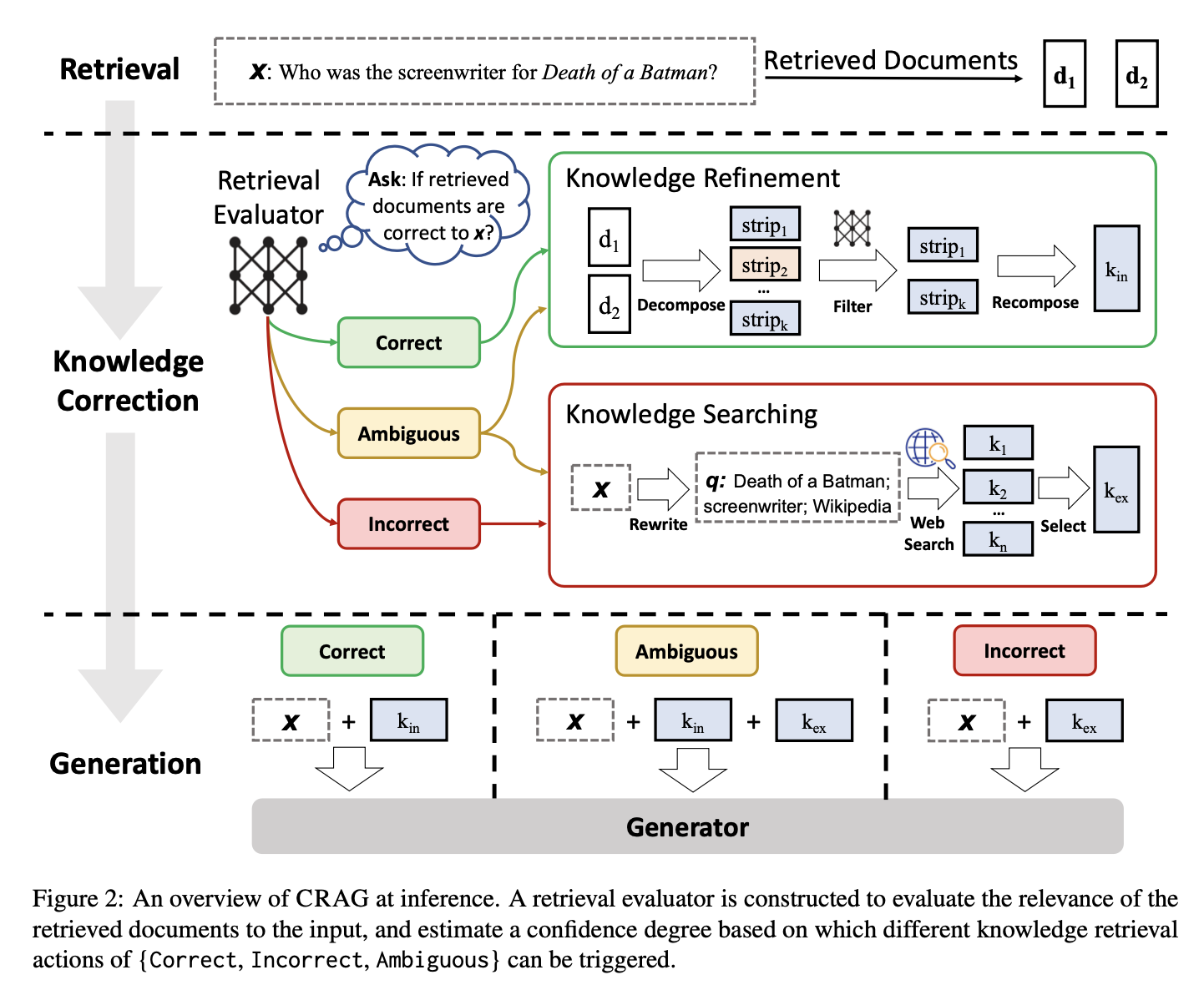
More at:
- paper -
- articles
See also C, ...
Correlation#
Correlation is not causation!
Correlation refers to the statistical relationship between two variables. In other words, it measures the extent to which two variables are related to each other.
A correlation can be positive or negative. A positive correlation means that the two variables move in the same direction. For example, if one variable increases, the other variable also tends to increase. A negative correlation means that the two variables move in opposite directions. For example, if one variable increases, the other variable tends to decrease.
Correlation can be measured by a statistic called the [correlation coefficient], which ranges from -1 to +1.
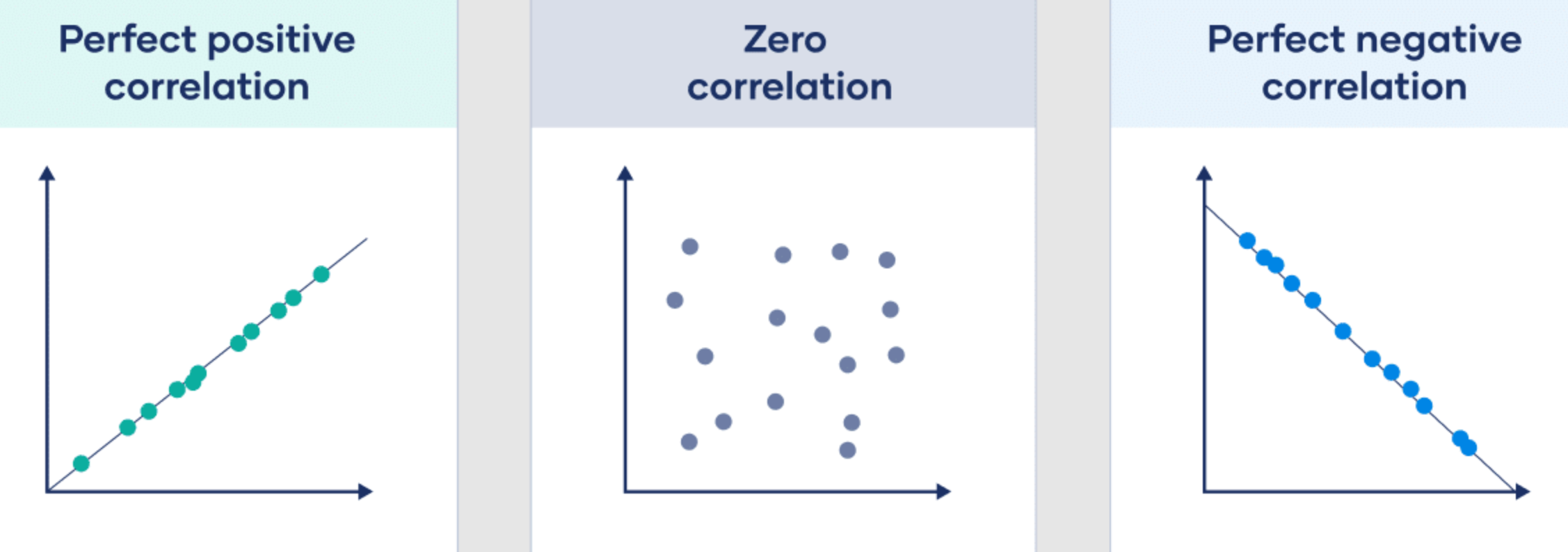
More at:
See also C, ...
Correlation Coefficient#
In Statistics, correlation or dependence is any statistical relationship, whether causal or not, between two random variables.
| Correlation coefficient | Correlation strength | Correlation type |
|---|---|---|
| -0.7 to -1 | Very strong | Negative |
| -0.5 to -0.7 | Strong | Negative |
| -0.3 to -0.5 | Moderate | Negative |
| -0 to -0.3 | Weak | Negative |
| 0 | None | Zero |
| 0 to 0.3 | Weak | Positive |
| 0.3 to 0.5 | Moderate | Positive |
| 0.5 to 0.7 | Strong | Positive |
| 0.7 to 1 | Very strong | Positive |
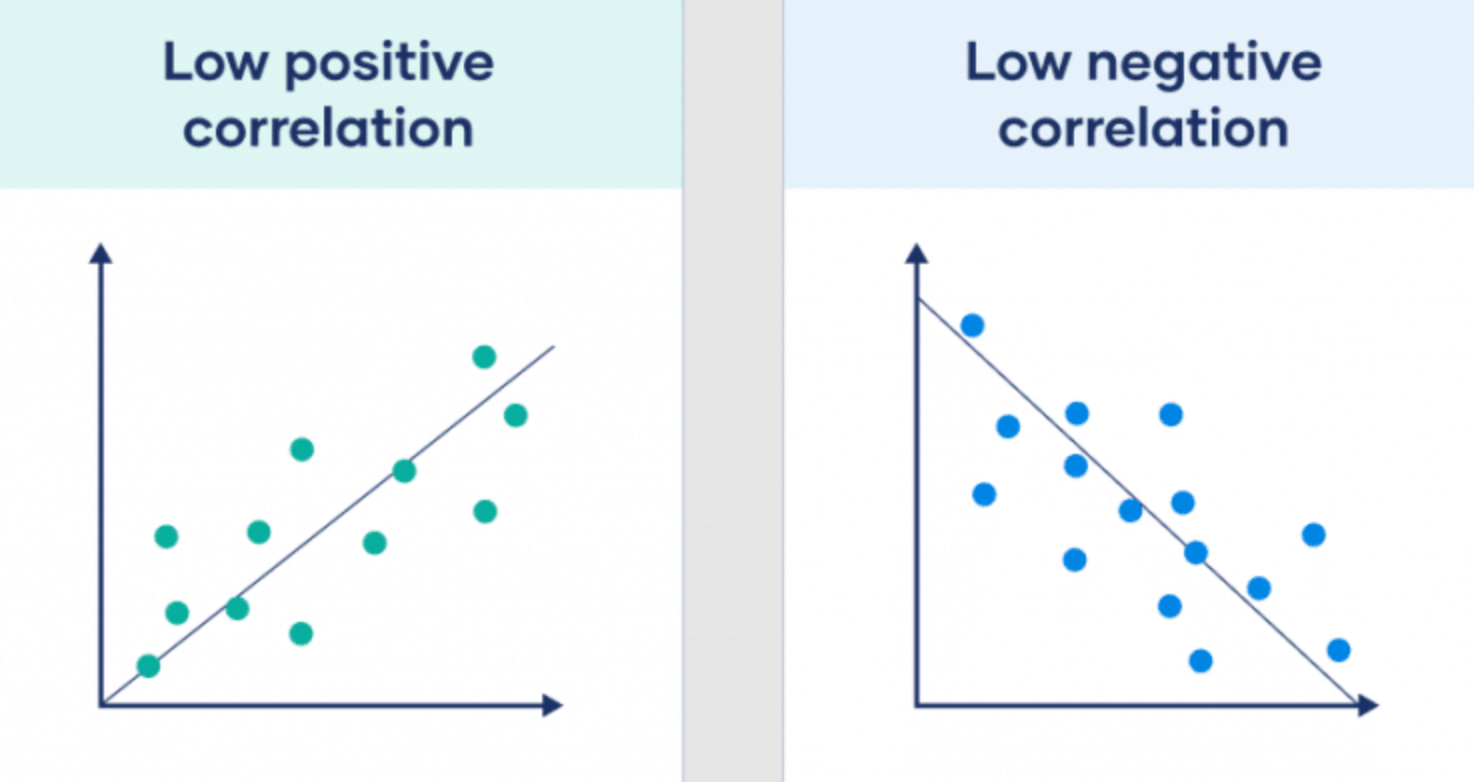
More at:
See also C, ...
Correlation Matrix#
# Correction Matrix Plot (generic)
from matplotlib import pyplot
from pandas import read_csv
import numpy
filename = 'pima-indians-diabetes.data.csv'
names = ['preg', 'plas', 'pres', 'skin', 'test', 'mass', 'pedi', 'age', 'class']
data = read_csv(filename, names=names)
correlations = data.corr()
# plot correlation matrix
fig = pyplot.figure()
ax = fig.add_subplot(111)
cax = ax.matshow(correlations, vmin=-1, vmax=1)
fig.colorbar(cax)
pyplot.show()

See also C, ...
Cortical Labs Company#
A company that is trying to build a chip dubbed DishBrain with biological [neurons] to do AI.
The biggest cost out of any data center or cloud provider is the energy that they pay for running the equipment and cooling the system. DishBrain is a system that consumes hardly any energy and outputs very little heat. The unit economics completely flips on its head, especially if you can start training it to do AI tasks.
{% pdf "../pdf/c/cortical_labs_neuron_paper.pdf" %}
More at:
- site - https://corticallabs.com/
- research - https://corticallabs.com/research.html
- articles
See also C, ...
Cosine Similarity Function#
A similarity metric that can tell us how similar or different 2 embeddings are
In data analysis, cosine similarity is a measure of similarity between two non-zero vectors defined in an inner product space. Cosine similarity is the cosine of the angle between the vectors; that is, it is the dot product of the vectors divided by the product of their lengths. It follows that the cosine similarity does not depend on the magnitudes of the vectors, but only on their angle. The cosine similarity always belongs to the interval [ −1, 1]. For example, two proportional vectors have a cosine similarity of 1, two orthogonal vectors have a similarity of 0, and two opposite vectors have a similarity of -1.
Can tell us how similar or different 2 phrases are.
- 2 same sentences, are the exact same, then the cosine similarity is cos(0) = 1
- 2 sentences have no words in common, then the angle between 2 phrases is 90 deg, cosine similarity is cos(90 deg) = 0
- 2 sentences have some words in common, then cosine similarity is between 0 and 1
Step-by-step
- Make a table of word counts
- Plot the points
- Figure out angle
- Calculate the Cosine of the angle
Beware:
- Use angles only! Not the magnitudes of the vectors unlike the Euclidean distance.
- The number of times a word appears does not change the cosine similarity, e.g. "hello hello world" is exactly same as "hello world"
- Each word adds a new dimension. So for more than 2 words, use the cosine similarity formula (but assume the math-context is the same)
Here is an illustration for a cosine similarity for 2 sentences with only 2 words (2 dimensions)
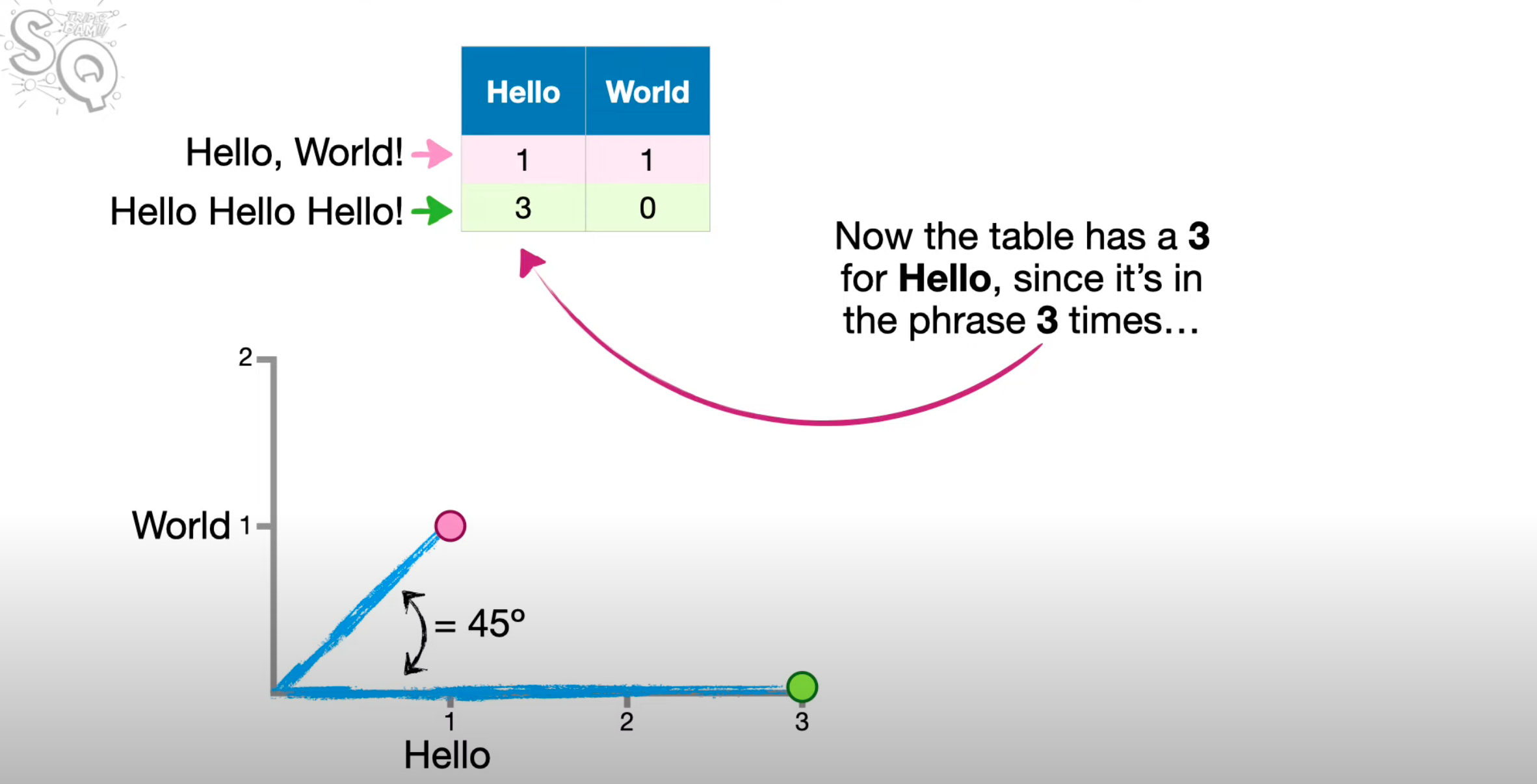
Here is the formula for the cosine similarity for N words (N dimensions)
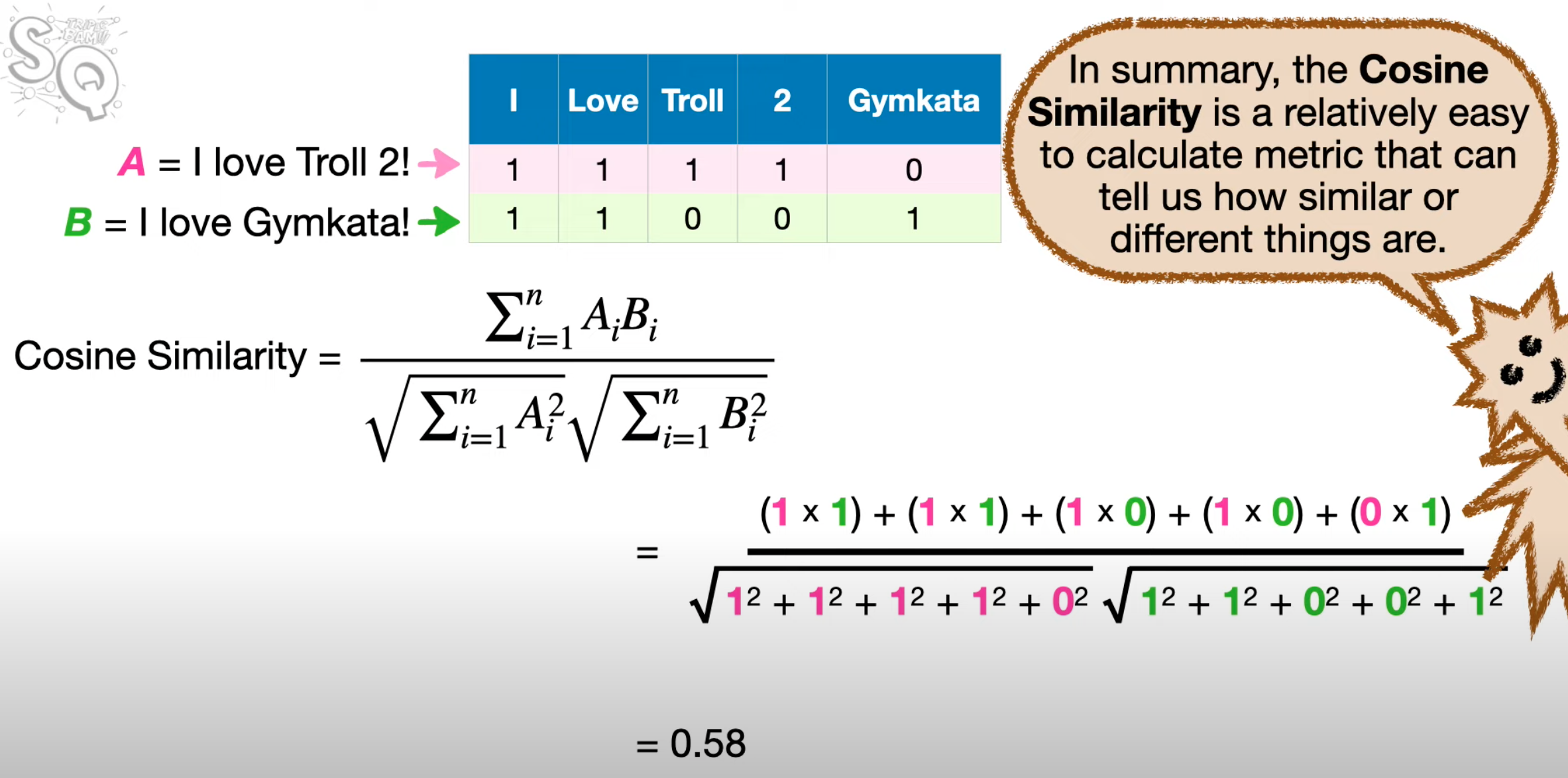
More at:
See also C, ...
Cost#
Cost vs Reward = minimize vs maximize
Cost = negative reward
Cost Function#
See Loss Function
Covariant AI Company#
Models
- [Robot Foundational Model]
More at:
- site - https://covariant.ai/
See also C, ...
Covector#
A linear "machine" that eats a vector and output a number (a measurement)
Linear means:
- V1 + V2 --> transformation of V1 + transformation of V2
- a * V1 --> a * transformation of V1

See also C, ...
CreateML Application#
An application to easily create ML models
More at:
See also C, CoreML Framework
Critic#
In reinforcement learning, when using an actor-critic algorithm, a critic is Q-learning algorithm that critiques the action that the actor selected, providing feedback on how to adjust. It can take advantage of efficiency tricks in Q-learning, such as memory replay.
In deep RL, a critic is an artificial neural network that computes the Q-value
See also C, ...
Critic Network#
See also C, ...
Critical Assessment of Structure Prediction (CASP) Challenge#
Critical Assessment of Structure Prediction (CASP), sometimes called Critical Assessment of Protein Structure Prediction, is a community-wide, worldwide experiment for protein structure prediction taking place every two years since 1994. CASP provides research groups with an opportunity to objectively test their structure prediction methods and delivers an independent assessment of the state of the art in protein structure modeling to the research community and software users. Even though the primary goal of CASP is to help advance the methods of identifying protein three-dimensional structure from its amino acid sequence many view the experiment more as a “world championship” in this field of science. More than 100 research groups from all over the world participate in CASP on a regular basis and it is not uncommon for entire groups to suspend their other research for months while they focus on getting their servers ready for the experiment and on performing the detailed predictions.
In December 2018, CASP13 made headlines when it was won by AlphaFold, an artificial intelligence program created by DeepMind. In November 2020, an improved version 2 of AlphaFold won CASP14. According to one of CASP co-founders John Moult, AlphaFold scored around 90 on a 100-point scale of prediction accuracy for moderately difficult protein targets. AlphaFold was made open source in 2021, and in CASP15 in 2022, while DeepMind did not enter, virtually all of the high-ranking teams used AlphaFold or modifications of AlphaFold.
More at:
See also C, ...
Cross-Attention#
~ 2 sequences (input vs output, i.e. English to French translation) and 2nd one attends to elements/words in the first one.
Allow the decoder to access information from encoders to make better predictions. In text-to-image generation, through the cross-attention mechanism, the information of the text is fused to the visual feature vectors.
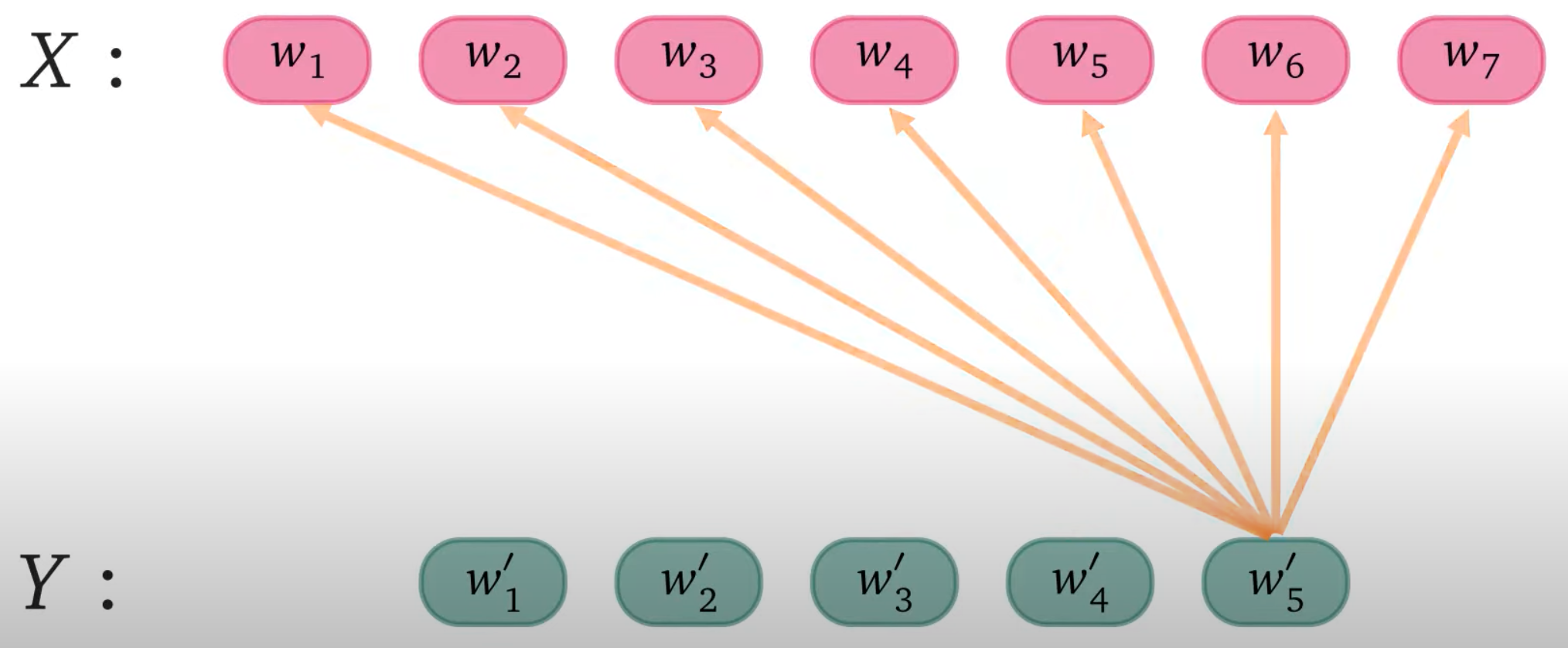
See also C, Attention, [Latent Diffusion Model], Self-Attention, Transformer Architecture
Cross-Entropy#
used as a loss function in a classifier
See also C, Cross-Entropy Loss Function, Entropy, [Perplexity]
Cross-Entropy Loss Function#
~ classic loss function for classification
Frequently used as a loss function for neural networks. To understand it, you need to understand the following (and in that order!): Surprisal, Entropy, Cross-Entropy, Cross-Entropy Loss.
- Surprisal: “Degree to which you are surprised to see the result”. Now it's easy to digest my word when I say that I will be more surprised to see an outcome with low probability in comparison to an outcome with high probability. Now, if Pi is the probability of ith outcome then we could represent surprisal (s) as:
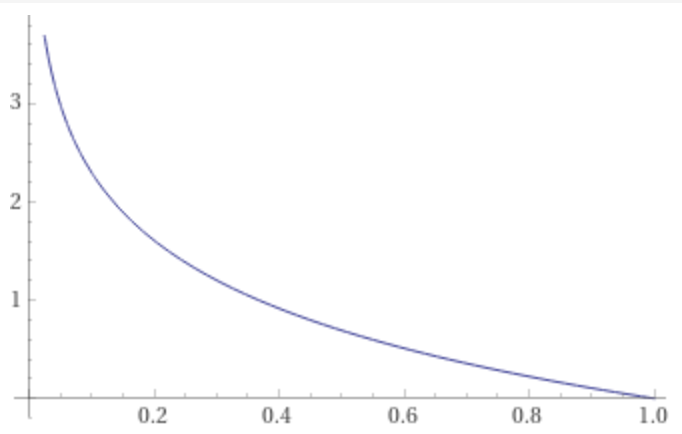
- Entropy: Since I know surprisal for individual outcomes, I would like to know surprisal for the event. It would be intuitive to take a weighted average of surprisals. Now the question is what weight to choose? Hmmm…since I know the probability of each outcome, taking probability as weight makes sense because this is how likely each outcome is supposed to occur. This weighted average of surprisal is nothing but Entropy (e) and if there are n outcomes then it could be written as:
- Cross-Entropy: Now, what if each outcome’s actual probability is Pi but someone is estimating probability as Qi. In this case, each event will occur with the probability of Pi but surprisal will be given by Qi in its formula (since that person will be surprised thinking that probability of the outcome is Qi). Now, weighted average surprisal, in this case, is nothing but cross-entropy(c) and it could be scribbled as:
Cross-entropy is always larger than entropy and it will be same as entropy only when Pi=Qi
- Cross-Entropy Loss: In the plot below, you will notice that as estimated probability distribution moves away from actual/desired probability distribution, cross-entropy increases and vice-versa. Hence, we could say that minimizing cross-entropy will move us closer to actual/desired distribution and that is what we want. This is why we try to reduce cross-entropy so that our predicted probability distribution end up being close to the actual one. Hence, we get the formula of cross-entropy loss as:
cross-entropy loss = c = sum(0, n, Pi * log (1/Qi)
# And in the case of binary classification problem where we have only two classes, we name it as binary cross-entropy loss and above formula becomes:
binary cross-entropy loss = c = sum(0, 1, Pi * log (1/Qi) = Po * log(1/Qo) + (1-Po) * log(1/Q1)


This plot helps you visualize the cross-entropy between two distributions. The Red function represents a desired probability distribution, for simplicity a gaussian distribution is shown here. While the Orange function represents estimated probability distribution. The purple bar shows cross-entropy between these two distributions which is in simple words the area under the blue curve.
More at
- plot - https://www.desmos.com/calculator/zytm2sf56e
- https://medium.com/@vijendra1125/understanding-entropy-cross-entropy-and-softmax-3b79d9b23c8a
- https://machinelearningmastery.com/cross-entropy-for-machine-learning/
See also C, [Binary Cross-Entropy Loss Function], Cross-Entropy, Entropy, Loss Function
Cross-Validation on Historical Data#
See [#Backtesting]
Cross-Validation Sampling Method#
~ used to find the sweet spot for balanced fitting
~ not using cross-validation is like judging a chef on 1 meal and one meal only!
= to merge in k-fold cross validation?
Cross-validation is a powerful preventative measure against overfitting. The idea is clever: Use your initial training data to generate multiple mini train-test splits. Use these splits to tune your model (eg complexity). In standard k-fold cross-validation, we partition the data into k subsets, called folds. Then, we iteratively train the algorithm on k-1 folds while using the remaining fold as the test set (called the “holdout fold”). Cross-validation allows you to tune hyperparameters with only your original training set. This allows you to keep your test set as a truly unseen dataset for selecting your final model.
See also C, Dataset, Development Subset, Holdout Fold, Resampling Method, [Testing Subset], [Training Subset], Validation Set
Cubic Regression#
See also C, Non-Linear Regression, Regression
Cuda Core
CUDA#
See also C, ...
CUDA Core#
parallel general processing - more accuracy (than a tensor core)
See also C, ...
Cumulative Distribution Function (CDF)#
Graph or histogram reporting the probability that a function has reached this value or is below.
See also C, Distribution
Cumulative Reward#
In Reinforcement Learning (RL) the agent is going to learn to maximize its cumulative reward, not the immediate reward. To make sure the agent adopt the correct behavior, you must understand the agent incentive, that is the cumulative reward!
See also C, Reward Shaping
Curiosity-Driven RL#
More at:
- random distillation paper - https://arxiv.org/abs/1810.12894
See also C, ...
Curriculum Learning#
When you teach addition, do you start with a complex or simple example?
Curriculum learning is a training strategy in machine learning where models are trained on increasingly complex subsets of the full training data. The idea is to start with easier examples first and then gradually increase the difficulty as the model learns. Some key aspects of curriculum learning:
- Data is organized from simple to complex. For example, in image classification, the model may first be trained on images with solid backgrounds before moving to more varied images.
- The curriculum is designed thoughtfully based on some measure of "difficulty". This could be manually defined by a human or automated based on model performance.
- Models are able to master simpler concepts first, which provides a better initialization for learning more complex examples later.
- Curriculum learning can lead to faster convergence compared to training on all data from the start.
- It is most useful when the training data has an inherent meaningful order from simple to complex. Curriculum design is important.
- Curriculum learning has been shown to be beneficial for training deep neural networks in domains like computer vision and natural language processing.
So in summary, curriculum learning trains models incrementally on curated subsets of data ordered by increasing complexity, allowing for faster and more robust learning. The curriculum design and measures of difficulty are key aspects.
See also C, ...
Curse of Dimensionality#
Custom Churn Prediction#
See also C, Regression, Supervised Learning
Custom GPT#
You can now create custom versions of ChatGPT or GPT-4 that gives them personalities and combine instructions,extra knowledge, and any combination of skills.
Beware, Custom GPTs can be easily reverse engineered using different methods of prompt injection
More at:
- announcement - https://openai.com/blog/introducing-gpts
- create one - https://chat.openai.com/create
- examples
- math mentor - https://openai.com/chatgpt#do-more-with-gpts
- articles
- tools
- UI - https://retool.com/use-case/gpt4-gui-frontend
- chatbot UI - https://www.voiceflow.com/
- website into knowledge bases - https://www.youtube.com/watch?v=CFMK_707xqg
- whatsapp UI - https://manychat.com/
- GPT finders
See also C, ManyChat Company, Replit Company, VoiceFlow Company
Cybernetic Organism (Cyborg)#
A cyborg, short for "cybernetic organism," refers to a being that combines both biological and artificial components. It is a concept derived from science fiction and represents a fusion of human and technological elements.
In a general sense, a cyborg can encompass a range of entities, from individuals with prosthetic limbs or implants that enhance their physical capabilities to more advanced combinations where artificial components are integrated deeply into the body and nervous system.
Cyborgs can be created for various purposes, including medical reasons, such as providing assistance to individuals with disabilities or injuries, or for enhancing human performance and capabilities beyond natural limits. This can involve incorporating electronic devices, sensors, or implants that connect to the body's systems to provide new functionalities or augment existing ones.
The concept of cyborgs raises ethical and philosophical questions about the boundaries between human and machine, the impact on identity and autonomy, and the potential implications for society as technology advances. While there are real-world examples of individuals with artificial limbs or implants, the depiction of highly integrated and advanced cyborgs seen in science fiction is yet to be fully realized.
More at:
See also C, ...
Cyborg Bettle#
More at:
See also C, ...
Cyc Expert System#
Probably the longest-running expert system project, called Cyc (from the world encyclopedic) created by Douglas Lenat and his colleagues at Cycorp. Initiated in 1984, Cyc has the goal of encoding all of "commonsense knowledge" - broadly known as facts like 'a dropped egg will break' or 'A child running through the kitchen with muddy shoes will annoy parents'. These millions of small ideas are not clearly written down in one place. They are unspoken assumption s underlying human behavior and reasoning that are necessary for understanding what the average person knows in a variety of domains. Yet, because the Cyc system also represents this knowledge with symbolic rules, it too has to face the complexity ceiling.
More at:
- site - https://cyc.com/
See also C, ...
Cycle GAN#
Image-to-image translation involves generating a new synthetic version of a given image with a specific modification, such as translating a summer landscape to winter. This opens up the possibility to do a lot of interesting tasks like photo-enhancement, image colorization, style transfer, season translation, object transfiguration, and generating photos from paintings, etc. Traditionally, training an image-to-image translation model requires a dataset comprised of paired examples. That is, a large dataset of many examples of input images X (e.g. summer landscapes) and the same image with the desired modification that can be used as an expected output image Y (e.g. winter landscapes). The requirement for a paired training dataset is a limitation. These datasets are challenging and expensive to prepare, e.g. photos of different scenes under different conditions. In many cases, the datasets simply do not exist, such as famous paintings and their respective photographs. As such, there is a desire for techniques for training an image-to-image translation system that does not require paired examples. Specifically, where any two collections of unrelated images can be used and the general characteristics extracted from each collection and used in the image translation process. For example, to be able to take a large collection of photos of summer landscapes and a large collection of photos of winter landscapes with unrelated scenes and locations as the first location and be able to translate specific photos from one group to the other. This is called the problem of unpaired image-to-image translation.
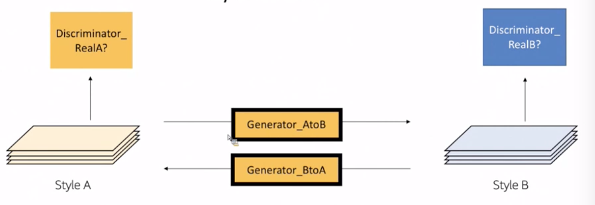
At first glance, the architecture of the CycleGAN appears complex. Let’s take a moment to step through all of the models involved and their inputs and outputs. Consider the problem where we are interested in translating images from summer to winter and winter to summer. We have two collections of photographs and they are unpaired, meaning they are photos of different locations at different times; we don’t have the exact same scenes in winter and summer.
- Collection 1: Photos of summer landscapes.
- Collection 2: Photos of winter landscapes.
We will develop an architecture of two GANs, and each GAN has a discriminator and a generator model, meaning there are four models in total in the architecture. The first GAN will generate photos of winter given photos of summer, and the second GAN will generate photos of summer given photos of winter.
- GAN 1: Translates photos of summer (collection 1) to winter (collection 2).
- GAN 2: Translates photos of winter (collection 2) to summer (collection 1).
Each GAN has a conditional generator model that will synthesize an image given an input image. And each GAN has a discriminator model to predict how likely the generated image is to have come from the target image collection. The discriminator and generator models for a GAN are trained under normal adversarial loss like a standard GAN model. We can summarize the generator and discriminator models from GAN 1 as follows:
- Generator Model 1:
- Input: Takes photos of summer (collection 1).
- Output: Generates photos of winter (collection 2).
- Discriminator Model 1:
- Input: Takes photos of winter from collection 2 and output from Generator Model 1.
- Output: Likelihood of image is from collection 2.
So far, the models are sufficient for generating plausible images in the target domain but are not translations of the input image.

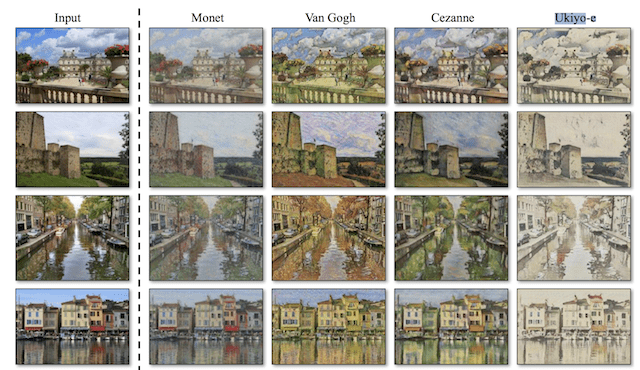
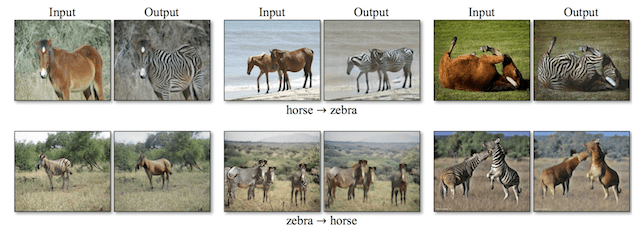
Beware:
- input can be an image of frequencies that represent a voice and therefore can be used to change your voice!
More at:
See also C, [Generative Adversarial Network], [Spectrogram Image]